

What are Africa’s Big Five? Meet the continent’s most iconic wildlife
Once mostly targeted by hunters, these large species are “awe-inspiring” sights for safari-goers.
If you’ve gone on an African safari , chances are you’ve heard of the Big Five, the must-see list of iconic megafauna.
Lions , leopards, elephants , African buffalo , and rhinoceroses are “what people think of when they think of Africa and wildlife,” says Natalia Borrego , a research associate at the University of Minnesota Lion Center.
The term, coined in the late 1800s during Africa’s colonial period , refers to what trophy hunters considered the most challenging and dangerous animals to hunt on foot.
These animals are still hunted today , but a shift toward tourism has also made seeing the Big Five an “awe-inspiring” goal for any safari-goer, Borrego says.
That’s especially true because all of these species are decreasing in population—lions in particular are struggling, having lost 94 percent of their original habitat . Only about 20,000 of the big cats remain in the wild.
Here’s are some fascinating facts about the Big Five.
This is the most elusive, and also the smallest, of the five. “I call them ninja cats because they’re just sneaky and they’re harder to spot,” Borrego says.
Speaking of spots, most leopards are light-colored, with distinctive dark spots that are called rosettes. Black leopards, which appear to be almost solid in color because their spots are hard to distinguish, are commonly called black panthers .
The solitary big cats haul large kills, such as zebra or antelope, into a tree to eat alone, in peace.
There’s another reason for leopards to stay aloft: They don’t exactly get along with their fellow Big Fiver, the African lion. If a lion has a chance to kill a leopard, it will. (Related: “ A lioness killing a leopard floored these filmmakers .”)
African lion
Lions are the only social big cat, but don’t expect to see the king. There isn’t one.
These big cats are “not born into a rank,” Borrego says. “They are egalitarian, which means they don’t have a permanent social hierarchy.”
One male may be dominant over the others, but that can change at any time.
Lion society is also matrilineal, “so the females hold the territories,” and stay with the pride into which they’re born. (Related story: “ In real life, Simba’s mom would be running the pride .”)
African buffalo
These hefty, cow-like animals often congregate by the thousands in the Serengeti; forming large groups is one defense against predators.
Male and female buffalo both have horns, but the males’ curve upward and fuse together in the center, forming a solid bony plate called a boss. It’s a helpful defense—as is being more than three times heavier than their lion adversaries.
That’s why a lion that attacks a buffalo is taking a huge risk of dying. Buffalo can be aggressive, and frequently come into conflict with humans outside of protected areas.
African elephant
The biggest of the Big Five is the African savanna elephant, which can weigh up to seven tons. The African forest elephant, which is about three feet shorter and lives in the forests of the Congo Basin, was declared a separate species after genetic testing in 2010 showed big differences between the forest and savanna dwellers.
Savanna elephants are large enough to change the landscape , pulling up trees to make grasslands, dispersing seeds, and overall increasing biodiversity.
Long sought after by poachers, elephants have a fragmented range throughout central and southern Africa .
Rhinoceroses
There are two species—the black rhinoceros and the white rhinoceros—and five subspecies between them left in Africa. Those include the northern white rhino, the southern white rhino, the eastern black rhino, the southern central black rhino, and the southwestern black rhino.
All are huge, with a top weight of 5,000 pounds and horns that can grow up to five feet long.
Due largely to poaching for their horns , the western black rhino was declared extinct in 2011 . The last male northern white rhino died in 2018 , with only two females remaining—making that subspecies functionally extinct. ( Learn about the different types of extinction .)
About 20,000 southern white rhinos remain, mostly in southern Africa. Conservation efforts have helped increase the population of the smaller, critically endangered black rhino , found mainly in East and southern Africa.
Other Fives
Africa is incredibly rich in wildlife, which is why several other “fives” have popped up over the years, such as the Little Five —including the leopard tortoise and the elephant shrew—the Shy Five , and the Ugly Five , which, to say the least, is a bit subjective. ( Read why people find “ugly” animals cute .)
With over 2,000 bird species in Africa , can we also get a High Five?
FREE BONUS ISSUE
Related topics.
- AFRICAN LIONS
- WATER BUFFALO
- WILDLIFE CONSERVATION
You May Also Like

Are South Africa’s captive lions inbred?

Who buys lion bones? Inside South Africa’s skeleton trade

Why Poison Is a Growing Threat to Africa’s Wildlife

See our best wildlife photos from 2023

Does your favorite travel company promote harmful wildlife activities?
- Perpetual Planet
- Environment
- Paid Content
History & Culture
- History & Culture
- Photography
- Mind, Body, Wonder
- Gory Details
- 2023 in Review
- Best of the World
- Terms of Use
- Privacy Policy
- Your US State Privacy Rights
- Children's Online Privacy Policy
- Interest-Based Ads
- About Nielsen Measurement
- Do Not Sell or Share My Personal Information
- Nat Geo Home
- Attend a Live Event
- Book a Trip
- Inspire Your Kids
- Shop Nat Geo
- Visit the D.C. Museum
- Learn About Our Impact
- Support Our Mission
- Advertise With Us
- Customer Service
- Renew Subscription
- Manage Your Subscription
- Work at Nat Geo
- Sign Up for Our Newsletters
- Contribute to Protect the Planet
Copyright © 1996-2015 National Geographic Society Copyright © 2015-2024 National Geographic Partners, LLC. All rights reserved

The Big Five Animals
All about ‘the big five’ animals – african elephant, cape buffalo, leopard, lion, rhinoceros, the big five animals of africa are african elephant, cape buffalo, leopard, lion, and rhinoceros.
These five types of animals were named ‘the big five’ by big game hunters from African’s colonial era, as they were considered the most difficult and dangerous African beasts to hunt on foot. These days, of course, any shooting of Africa’s big five tends to be more about choosing the right lens ( photo safari anyone? )!
Jump to a section: African Elephant | Cape Buffalo | Leopard | Lion | Rhinoceros | Big five quotes | Best places to see the big five | Other wildlife ‘5s’
Read on below for a more in-depth look at each of the big 5 animals:
1. African Elephant
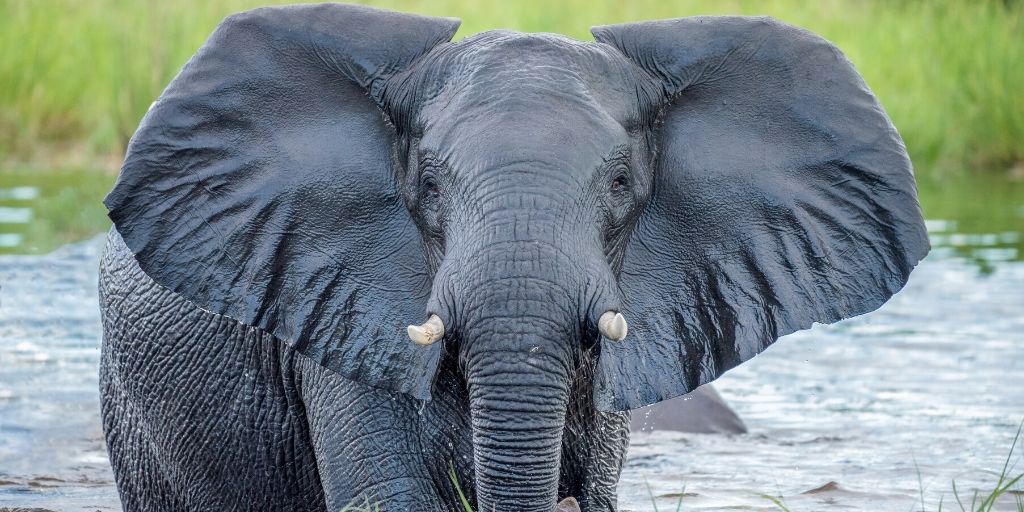
African elephants are the largest of the big five animals
The African elephant ( Loxodonta africana ) is the largest and heaviest land animal in the world, weighing up to 6 tonnes, and eating massive amounts of food each day.
Their distinguishing features include the dexterous trunk , large ears that cool the body when flapped, and elongated incisors in the form of tusks. There are actually two species of African elephant – the African bush elephant and the smaller African forest elephant. Both are herbivores that live in large groups, whilst the African bush elephant is the larger of the two species, and typically the species referred to as a member of the big five animals.
A bull elephant can be dangerous, as can herds or mothers with young elephants. Keep your distance from them, and if in a vehicle ensure that you have the means to drive away forwards – elephants can run faster than a car can reverse. An elephant flapping its ears, kicking up dust, and/or trumpeting is probably about to charge.
Group name: Herd
Size: Up to 3.3 meters tall, weighing 6,000kg.
Speed: Up to 40 km per hour.
Diet: Elephants are vegetarians, eating up to 160kg per day, made up of savannah grasses, bushes, small plants, fruit, twigs, tree bark, and roots. Read more about what elephants eat .
Range & Habitat: African Elephants are found across sub-Saharan Africa – from Mali in the north, through the central and west African forests, down to South Africa. They are adaptable animals, capable of surviving in many habitats, from lush wetlands to arid African deserts . Despite this, both species of African elephants are considered endangered species , and on the list of Africa’s most endangered animals .
Best places to see African elephants: Addo Elephant Park, South Africa, Chobe National Park , Botswana , Etosha National Park, Namibia , Hwange National Park, Zimbabwe , South Luangwa National Park, Zambia .
Read more about African elephants .
2. Cape Buffalo

A grumpy African buffalo
Weighing in at not too far short of a ton, the African buffalo ( Syncerus caffer ) has a reputation for being bad-tempered and dangerous. Whilst a solitary African buffalo is one of the most unpredictable safari animals (and dangerous, hence their inclusion in the term big five animals), they are usually a docile beast when in a herd… aside from their tendency to stampede en masse when alarmed.
Herds have clearly defined home ranges, the size of which is determined by the amount of food and water available.
Size: Up to 1.8 meters tall, and 800kg in weight.
Speed: They can run at speeds of up 57 kilometers per hour.
Diet: Cape buffalos are strictly herbivores and eat a wide variety of grasses, leaves, and other plants.
Habitat & Rage: Cape buffalo thrive in all sub-Saharan grasslands with access to water – from dry savanna to lowland floodplains.
Best places to see African Buffalo: Chobe National Park , Botswana , Katavi National Park, Tanzania , Kruger National Park, South Africa , Lower Zambezi National Park, Zambia.
Learn more about Cape Buffalo.
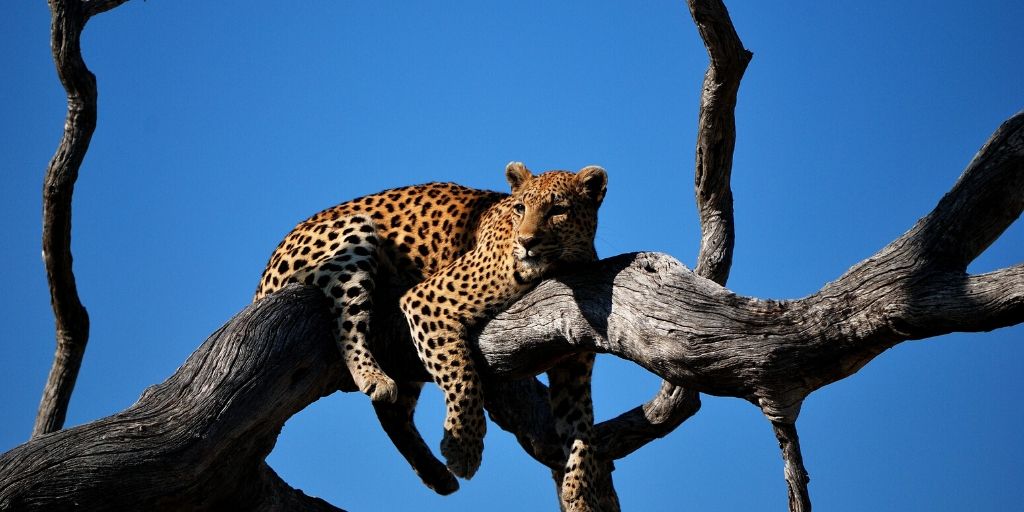
A stunning African leopard lounges in a tree in Kruger National Park, South Africa
Slightly smaller than their lion cousins, African leopards ( Panthera pardus ) are less rare than you might think, but rely on their animal camouflage and being active at night to stay hidden. Leopards are solitary, independent creatures, and rarely seen together except during mating, or a mother with cubs. As such they are totally self-reliant, and expert hunters – sometimes killing prey up to twice their size. During the daytime they often lounge around in trees and come to the ground after dark to hunt, taking their prey up into a tree to eat at their leisure.
Group name: Leap
Size: 1 meter high, weighing up to 100 kg.
Speed: 56 kilometers per hour.
Diet: Leopards are opportunistic carnivores and hunt a wide range of prey such as jackals , antelopes, gazelles , African monkeys , duiker, eland , impala , wildebeest , and more.
Range & Habitat: African leopards live in more places than any other types of big cat in Africa, and are comfortable in almost any habitat, including deserts, rainforests, woodlands, grassland savannas, mountain, scrub, and swamps. Leopards are one of the few big game species found outside national parks.
Best places to see Leopard: Londolozi Game Reserve, South Africa , Moremi Game Reserve , Botswana , Samburu National Reserve, Kenya, South Luangwa National Park, Zambia .
Learn more about leopards.

A male African lion and lioness relaxing
The African lion is the largest and most sociable of Africa’s cats , and one of Africa’s most dangerous animals . At up to 225kg, the lion ( Panthera leo ) really is the king of the savanna (it’s not a jungle animal !). Living in prides of up to 40 lions, it’s the lionesses who do all the hunting, usually sharing with the males of a pride. Lions are very territorial, and the females generally spend most of their lives within their home ranges.
If you encounter an African lion on foot don’t turn and run (easier said than done), as a running target that looks like prey will probably be viewed as such. Instead, try to make yourself look big, and back away gradually.
Group name: Pride
Size: 1.2 meters, weighing up to 225kg.
Speed: At a maximum speed of 80 kilometers per hour, the lion is the second fastest land animal in Africa .
Diet: African lions are apex predators and generally hunt the larger animals in their surroundings – buffalo, rhino, zebra, giraffe, and antelopes. Learn more about what lions eat .
Range & Habitat: Lions tend to prefer grassland, savanna, dense scrub, and open woodland. They are found across sub-Saharan African national parks, and also in a small part of north-east India.
Best places to see Lion: Kgalagadi Transfrontier Park, South Africa, Kruger National Park, South Africa , Maasai Mara National Reserve, Kenya , Ngorongoro Conservation Area, Tanzania , Okavango Delta, Botswana .
Read more about lions.
5. Rhinocerous

A white rhino walking in the bush
Once widespread through sub-Saharan Africa, the rhino has been hunted to the brink of extinction, and is probably the hardest of the big five to spot in the wild.
There are two species of rhinoceros in Africa – the critically endangered black rhino ( Diceros bicornis ) and the white rhino ( Ceratotherium simum ). Whilst white rhinos have made a comeback through conservation efforts across the continent, black rhinos are still very much one of Africa’s endangered animals . The fundamental differences between the white rhino and black rhino are not color, but rather size, temperament, food preference, and mouth shape. White rhinos have a flat, wide mouth, and their name comes from a mispronunciation of the Afrikaans word wide – “wijd”.
Both black rhinos and white rhinos tend to be wary of humans, but occasionally charge vehicles that get too close. If you’re on foot, then their bad eyesight should work in your favour – if they do charge you the apparent life-saving technique involves letting them get as close as possible, then stepping aside at the last second.
Group name: Crash
Size: 1.9 meters high and weighing up to 2,300kg
Speed: 50 kilometers per hour
Diet: All species of rhino are herbivores, grazing on a wide variety of fruits, stems, twigs, grasses, and leaves.
Range & Habitat: White rhinos are found throughout Asia and sub-Saharan Africa in habitats ranging from dense rainforests and swamps to grassy plains.
Best places to see Rhinoceros: Tends to be in Southern Africa – Etosha National Park , Namibia , Hluhluwe–Imfolozi Park, South Africa , Kruger National Park , South Africa, Lewa Wildlife Conservancy, Kenya , Mkomazi National Park, Tanzania.
Learn more about rhinos.
Best places to see all of the big five animals
Whilst we’ve highlighted national parks above to see each of the members of the big five animals, the ultimate thrill is to see all five animals on one safari. It’s not easy – not least because even if all five animals are present in an area they can still be very difficult to see! However, it is possible, as there are a number of hotspots in southern and east Africa that are rich in variety and can support an extremely dense wildlife population. Our top picks to see all of the big five together are:
- Chobe National Park, Botswana
- Etosha National Park in Namibia
- Kruger National Park in South Africa
- Londolozi Game Reserve in South Africa
- Maasai Mara National Reserve, Kenya
- Moremi Game Reserve, Botswana
- Ngorongoro Conservation Area, Tanzania
- South Luangwa National Park in Zambia
5 great quotes about each of the big five animals
Elephant quotes.

“They say an elephant never forgets. What they don’t tell you is, you never forget an elephant.”
Bill Murray
“Nature’s great masterpiece, an elephant; the only harmless great thing.”
“If anyone wants to know what elephants are like, they are like people only more so.”
Pierre Corneille
“He who mounts a wild elephant goes where the elephant goes.”
Randolph Bourne
Lion quotes

“Do not try to fight a lion if you are not one yourself.”
African proverb
“You know you are truly alive when you’re living among lions.”
Isak Dinesen
“Until the lion tells his side of the story, the tale of the hunt will always glorify the hunter.”
Zimbabwean proverb
“Lions make leopards tame.”
William Shakespeare
“In the jungle, the mighty jungle The lion sleeps tonight.”
Solomon Lina, “Mbube”
Leopard quotes

“At the top of the mountain we are all snow leopards. “
Hunter S. Thompson
“The leopard does not change his spots.”
King James Bible
“This world without a leopard…I mean, who would want to be here?! “
Diana Vreeland
“Leopard is an animal design, and my designs come from nature. “
Roberto Cavalli
“A leopard feels at home with leopard. “
George Eliot
Buffalo quotes
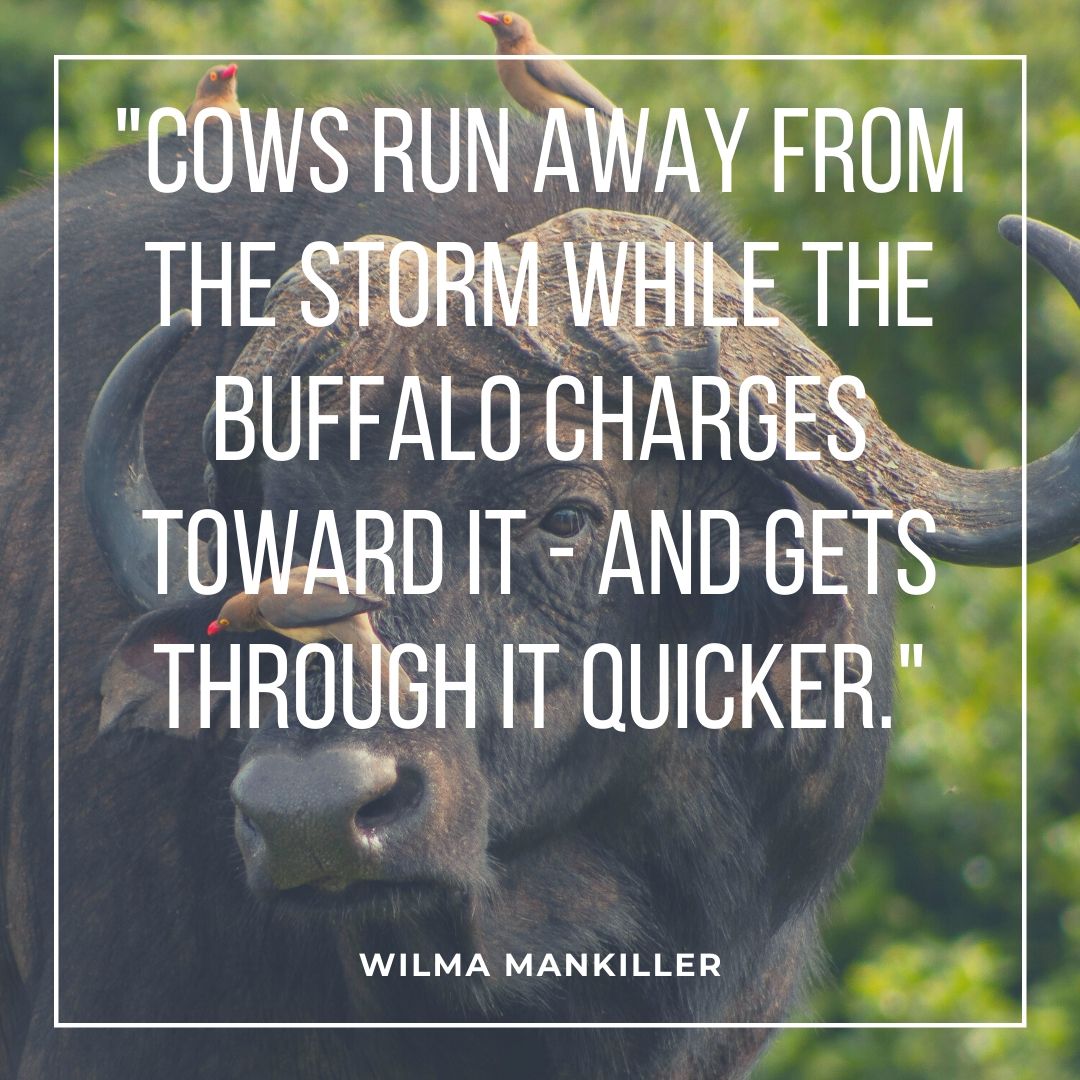
Cows run away from the storm while the buffalo charges toward it – and gets through it quicker. Whenever I’m confronted with a tough challenge, I do not prolong the torment, I become the buffalo.
Wilma Mankiller
The buffalo is a surprisingly stupid animal.
Ellsworth Huntington
So is the savage buffalo, especially delighting in dark places, where he can wallow in the mud and slake his thirst without much trouble
John Hanning Speke
At the rate science proceeds, rockets and missiles will one day seem like buffalo – slow, endangered grazers in the black pasture of outer space.
Bernard Cooper
The coat of the buffalo never pinches under the arm, never puckers at the shoulders; it is always the same, yet never old fashioned nor out of date.
Theodore Parker
Rhino quotes
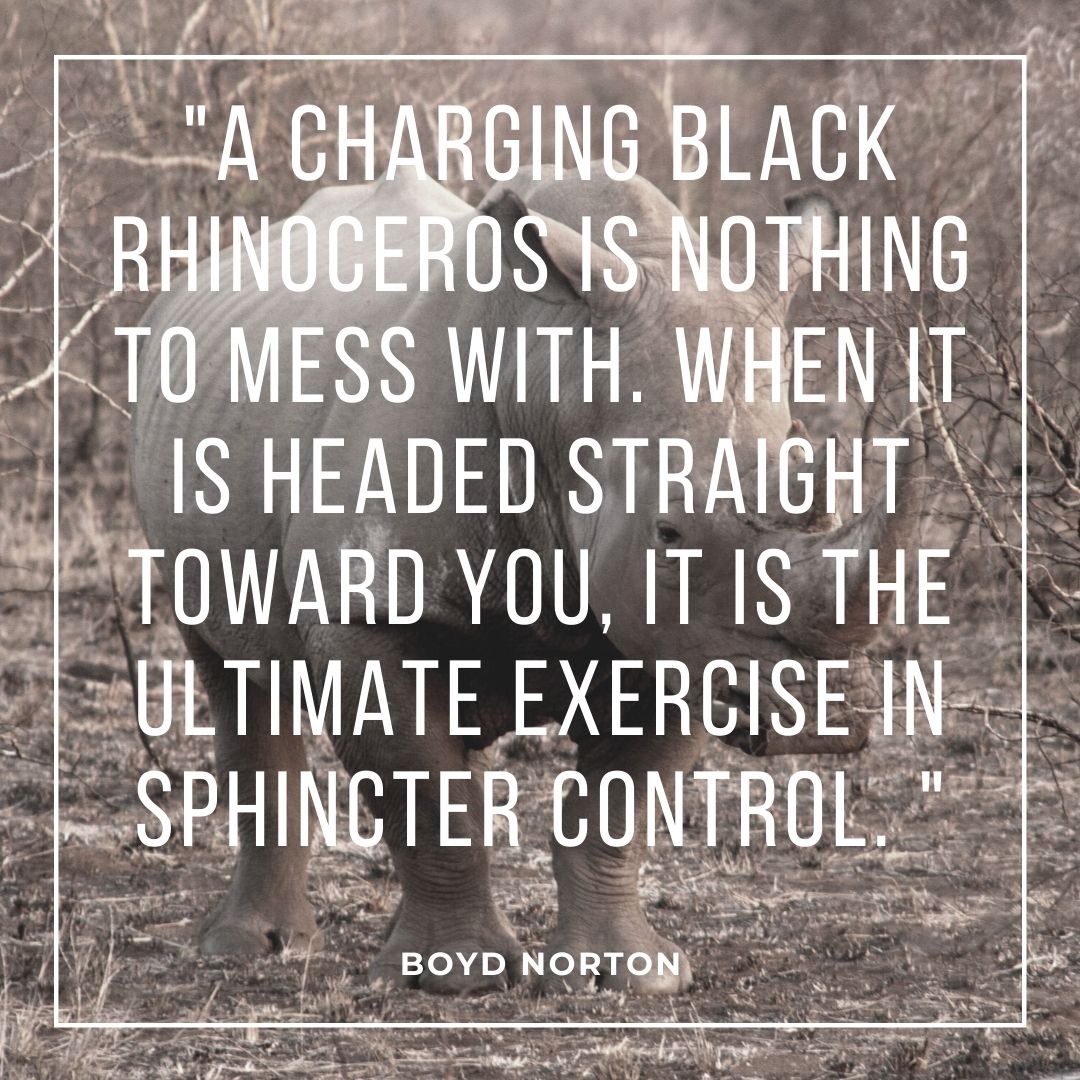
A charging black rhinoceros is nothing to mess with. When it is headed straight toward you, it is the ultimate exercise in sphincter control.
Boyd Norton
It is one thing to be amazed at gorgon or a griffin, creatures which do not exist; but it is quite another and much higher thing to be amazed at a rhinoceros or a giraffe, creatures which do exist and look as if they don’t.
G.K.Chesterton
The only way to save a rhinoceros is to save the environment in which it lives, because there’s a mutual dependency between it and millions of other species of both animals and plants.
David Attenborough
The rhinoceros stood about five hundred yards away, not a twentieth-century animal at all, but an odd, grim straggler from the Stone Age.
Winston Churchill
A rhinoceros is as ugly as a human being, and it too is going to die, but at least it never thinks that it is beautiful.
Peter S. Beagle
Other wildlife ‘fives’
Have you seen the big five animals and are are looking for a new wildlife challenge – other animals to hunt for your photo safari? For safari aficionados up for ticking all the ‘I’ve seen’ boxes, have you heard about the other groups of 5 animals?
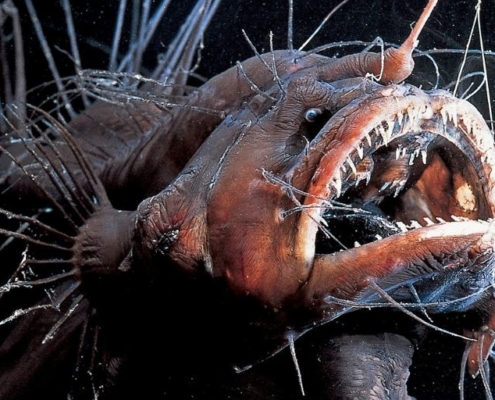
World’s Ugliest Fish
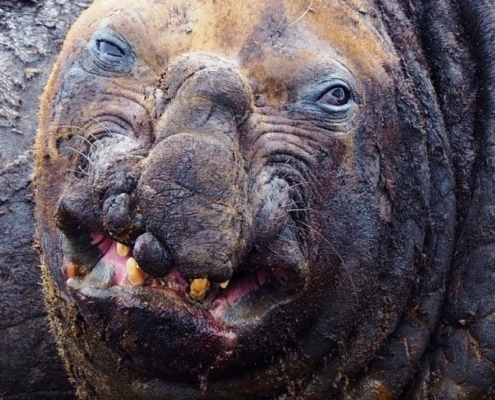
Ugly Animals
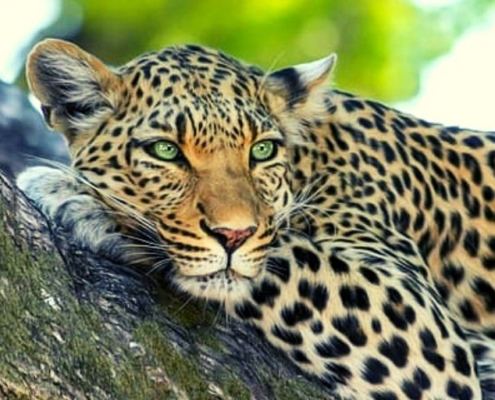
Best Places For The Big 5 In South Africa
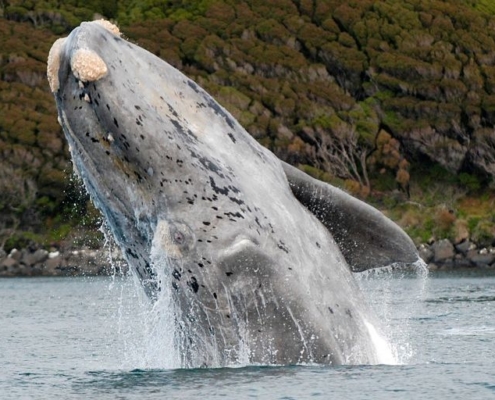
The Big Seven Animals – What They Are & Where To See Them
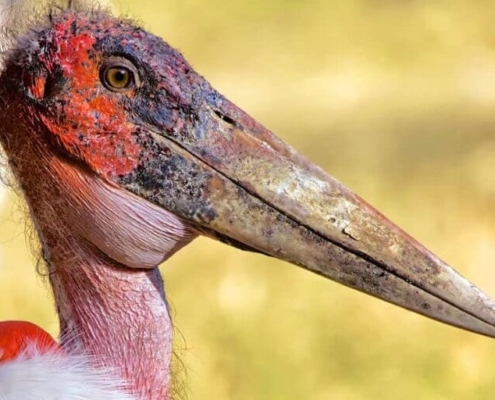
What Are ‘The Ugly Five’ Animals?
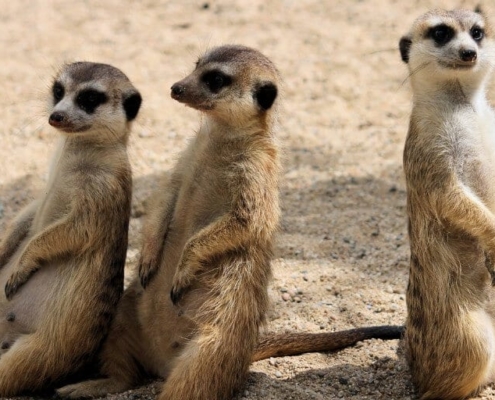
What Are ‘The Shy Five’ Animals?
Discover more of our wildlife posts…, most venomous spiders in the world, why do zebras have stripes, bioluminescent animals: 11 incredible animals that glow, birds of africa, understanding keystone species, debunking the ostrich head in sand myth, animals that mate for life, baobab – the upside down tree, the smallest mammals in the world.
I like the big five very much, but alittle bit surprised. The hippo i big than lion and leopard why is it not on the list. We heard that hippos are one of the animals which kills more people than elephants and rihnos
Hippos mainly live in the water, the Big Five live on land.
Hi Martin, the name is not everything! Hippos weren’t in the group of animals hunted for their skin or heads, so didn’t make the big five list ;)
The Big five are the animals that i love so much but they left the TIGER and its deserves to be on of them… if one could make them pets i’d long had one.
Unfortunately tigers are not native to Africa.
The big five is found all over Kenya and other parts of Africa.
Big five are found in Africa most distinctive in Tanzania, am proud of it.
My best animals are the big five
In my opinion the “Big Five” and all other wild animals wherever they are in the world should not be hunted down by big game hunters or poachers and the cowards who carry out these atrocities should themselves be hunted down and prosecuted to the fullest by the governments of those countries in which those activities occur.
Absolutely agree Eric – big game hunting is not something I can say I’m a fan of…
very useful to my resarch…
Glad to hear it Ryan ;)
Top countries for safaris
- Botswana safaris
- Kenya safaris
- Namibia safaris
- South Africa safaris
- Tanzania safaris
- Uganda safaris
Safari basics
- Safari animals
- How to find the right safari company
- When to go on safari
- What to take on safari
- Safari clothing – what to wear
- Safari rules & etiquette
- Wildlife spotting tips
Most read articles
- All about the ‘big five’ animals
- Collective nouns for animals
- Safari movies to watch before you go
- The world’s fastest land animals
- Apex predators
- 10 Fascinating African tribes
- The biggest animals in the world
- 17 Epic hybrid animals
- The world’s ugliest animals
- Why are flamingos pink?
Africa’s best game reserves
- Chobe National Park, Botswana
- Etosha National Park, Namibia
- Kruger National Park, South Africa
- Masai Mara National Reserve, Kenya
- Okavango Delta, Botswana
- Serengeti National Park, Tanzania

Session expired
Please log in again. The login page will open in a new tab. After logging in you can close it and return to this page.
An Introduction to Africa's Big Five Safari Animals
:max_bytes(150000):strip_icc():format(webp)/anoukmarrakech-56a373305f9b58b7d0d20299.jpg)
TripSavvy / Vin Ganapathy
If you're planning an African safari , you'll know that the term 'Big Five' is one of the most commonly used marketing slogans in the safari industry. Game reserves that host the Big Five will usually use this fact as their most significant selling point—but what does it mean? In the game reserves and national parks of Southern Africa , the Big Five represents safari royalty: the African lion, the African leopard, the African elephant, the Cape buffalo, and the rhino (either white or black).
The phrase was initially coined by early game hunters who recognized that these species were the most challenging and most dangerous animals to hunt on foot. This made them the biggest prizes, hence, the Big Five. Today, the phrase has come to represent the most sought-after safari sightings—although, in reality, this is a matter of personal preference. Some of the most endangered, beautiful, or charismatic African animals don't feature on the Big Five list, including the cheetah , the African wild dog, the giraffe, and the hippo.
African Elephant
The African elephant ( Loxodonta africana ) is the world's largest and heaviest land animal, with the biggest individual on record weighing in at over 10 tons/22,000 pounds. They are found in 37 sub-Saharan countries and can survive in a wide range of different habitats, from lush wetlands to arid deserts.
African elephants are supremely well adapted to their environment, from their inch-thick skin (which protects them from the sharp thorns of the bush) to their enormous ears (which help to disperse heat and regulate body temperature). They can consume up to 50 gallons of water and 375 pounds of vegetation every day.
Elephants are very social animals. They live in matriarch-led groups that often number more than 100 individuals and communicate using a variety of low-frequency rumbles that can travel for many miles. Female calves usually stay with the herd throughout their life, while young males leave to form bachelor groups and eventually create herds of their own.
In the 1970s and '80s, the global demand for ivory led to a dramatic decrease in elephant numbers. A ban on all ivory trade has helped stabilize the population to around 600,000 in the last decade. However, poaching is still a major issue, especially in parts of Africa where there is political instability. The African elephant is listed as Vulnerable on the IUCN Red List .
Where to See Elephants: Chobe National Park , Botswana; Addo Elephant National Park , South Africa; Hwange National Park , Zimbabwe; South Luangwa National Park, Zambia.
African Lion
The African lion ( Panthera leo ) is the undisputed king of the sub-Saharan savannah and is the world's second-largest cat after the tiger. Although lions sometimes hunt during the day, they are typically more active at night which is why most daytime safari sightings are of cats sleeping in the shade. Lions can sleep for up to 20 hours a day.
Unlike other cats, lions are very social animals. They live in prides, usually consisting of one (or sometimes two) males, several females, and their cubs. Lionesses typically do the hard graft when hunting, often working together to bring down larger prey. They are ambush hunters, using their tawny coloring as effective camouflage.
In the wild, lions can live to around 14 years, although most prides experience a high rate of cub mortality, while males often die while fighting to protect their territory. Female lions can synchronize the birth of their cubs to help each other raise them. Cubs are born with rosette markings that fade over time.
Lions have few natural predators, although buffalo will often trample cubs. Predictably, man is the species' biggest threat. Traditional hunting customs , big game hunters, and large-scale habitat loss have contributed to declining lion populations in Africa. The lion is also classified as Vulnerable on the IUCN Red List.
Where to See Lion: Kgalagadi Transfrontier Park, South Africa; Okavango Delta , Botswana; Maasai Mara National Reserve , Kenya, Ngorongoro Conservation Area, Tanzania.
African Leopard
The African leopard ( Panthera pardus ) is the most elusive of the Big Five animals. Naturally shy and exclusively nocturnal, leopards spend the daylight hours hidden from view. They are excellent climbers, using trees to scan for prey and store fresh kills away from scavengers like lions and hyenas. If you're looking for a leopard, remember to look up.
Leopards are superbly camouflaged with a series of black spots or rosettes. They have large territories and seldom stay in the same area for more than a few days. Males range more widely than females and mark their presence by urinating and leaving claw marks. They are powerful and can take down prey much larger than themselves.
Their hunting prowess relies on their ability to run at speeds of over 35 miles per hour. They can also jump over 10 feet into the air and are excellent swimmers. Leopards are distributed throughout sub-Saharan Africa and are one of the few big game species still found outside national parks.
White spots on the tip of their tails and the back of their ears make mothers visible to their cubs even in the long grass. As with the other Big Five species, leopards are threatened by humans. Encroaching farmlands have reduced their habitat, while farmers often shoot them to stop them from killing their livestock. They are listed as Vulnerable on the IUCN Red List.
Where to See Leopard: Londolozi Game Reserve, South Africa; Moremi Game Reserve, Botswana; South Luangwa National Park , Zambia; Samburu National Reserve, Kenya.
Cape Buffalo
Cape buffalo ( Syncerus caffer ) are found in water-rich game reserves and national parks throughout sub-Saharan Africa. There are four sub-species of Cape buffalo, the largest of which is the one most commonly seen in East and Southern Africa.
Cape buffalo are formidable creatures and have earned themselves a reputation as one of the most dangerous animals in Africa. They are often bad-tempered, especially when threatened, and are equipped with a fused set of deadly curved horns. Male buffalo can weigh as much as 2,000 pounds.
Despite their fierce reputation, buffalo are relatively peaceable with one another, sometimes congregating on the open grasslands in herds of over a thousand individuals. They are protective of their weaker members, often forming a defensive circle around sick or young animals when under attack from prowling lions.
Cape buffalo need to drink every day and are often found close to water. They eat tall, coarse grass and bushes, and as such cannot live in the desert. Cape buffalo continue to be one of the most sought-after trophy animals for big game hunters. They are exceptionally susceptible to domestic cattle diseases like rinderpest and bovine tuberculosis.
Where to see Cape Buffalo: Kruger National Park, South Africa; Chobe National Park, Botswana; Katavi National Park , Tanzania; Lower Zambezi National Park, Zambia.
White and Black Rhino
There are two rhino species in Africa: the black rhino ( Diceros bicornis ) and the white rhino ( Ceratotherium simum ). Both are at risk of extinction due to the poaching epidemic caused by the demand for rhino horns in Asian cultures. It is estimated that there are around 5,000 black rhinos and 20,000 white rhinos left in the wild.
Three subspecies of black rhino have been declared extinct, while the northern white rhino is now extinct in the wild. Conservationists are working tirelessly to protect the remaining sub-species, but their futures are far from secure. The black rhino is listed as Critically Endangered on the IUCN Red List.
Despite their names, there is no difference in color between the black and the white rhino. The easiest way to tell the species apart is to look at their lips—the black rhino's are pointed and prehensile, while the white rhino's are flat and wide. The Dutch word for "wide" is "wijd," and it is a mispronunciation of this word that gives the white rhino its name.
Black rhinos are usually solitary and have a reputation for being bad-tempered, while white rhinos often live in pairs. Black rhinos prefer desert and scrubland areas and are herbivorous browsers, while white rhinos graze on open savannah areas. It is thought that rhinos have roamed the African plains for 50 million years.
Where to See Rhino: Etosha National Park , Namibia; Hluhluwe–Imfolozi Park, South Africa; Lewa Wildlife Conservancy , Kenya; Mkomazi National Park, Tanzania
15 Animals to See on an African Safari
The Top 5 Places to See Lions in Africa
Fun Facts About African Animals: The Cheetah
Akagera National Park, Rwanda: The Complete Guide
Top 10 Unmissable African Safari Destinations
Forgotten Felines: The Seven Small Cats of Africa
Serengeti National Park, Tanzania: The Complete Guide
The Top 12 National Parks to Visit in Africa
The Best Places to Go in Southern Africa
Hluhluwe-Imfolozi Park, South Africa: The Complete Guide
Top 5 Self-Drive Safari Destinations in Southern Africa
10 of the Best Private Game Reserves in South Africa
10 of the Best Places to Visit in Botswana
South Luangwa National Park, Zambia: The Complete Guide
12 Nocturnal Animals to Look For on an African Safari
Kruger National Park: The Complete Guide

What are the Big 5 of Africa?
Why are they called the big five animals, the big five animals in pictures, big five animal facts, where to find the big five in africa, what are the best big five safari destinations, what are the best places to see all of the big 5, when is the best time to see the big five in africa, the african big five and wildlife conservation status, other popular five animal combinations, learn about the big 5 on safari in africa, guide to the big 5 animals of africa, receive photography and travel tips.

What are the Big 5 animals of Africa and where to find them?
The Big Five animals of Africa , in short, 'The Big 5' include the African elephant , rhinoceros , lion , leopard , and Cape buffalo . These five big game animal species are found on the African continent in the Southern and Eastern parts of Africa. As the name suggests, they are not the heaviest or the 5 biggest safari animals.
If it was about the size or weight of the African animal , a gorilla or hippo could also easily fit in. A hippo is for example three times heavier than a Cape buffalo and a male gorilla and male lion can both weigh up to 225kg.
The Big Five game refers to the 5 African animals that big game hunters in the late 1800s, during Africa's colonial period, considered the most dangerous and difficult wild animals to track and hunt on foot. Hunting these African game animals got them the biggest prices and trophies. Dangerous, because of their behavior when they feel threatened or get injured. Sadly, this wildlife is still hunted today but luckily there are also a lot of conservation initiatives to protect these threatened species that are decreasing in population and struggling because of habitat loss.
Nowadays, the term 'Big Five' is more a commercial term used by safari companies to sell their 'African Big 5 Safari trips' and to describe the Top 5 safari animals to see on a game drive . This made them also the most famous large African animals to look for on a safari trip to Africa. Ticking off the Big 5 is therefore on many travelers’ bucket lists. However, there's much more wildlife worth seeing roam freely in their natural habitat, like the cheetah, a tall elegant giraffe, a spotted Hyena, or a pack of African wild dogs. Even smaller creatures, like Dung Beetles or all the colorful birdlife, play an important role in the ecosystems.
So, with this article, I also want to raise awareness about the fact that there's more to Africa than spotting the Big Five , which is a hunting term after all.
That is also the main reason for setting up the New Big Five project, an international initiative to create a new Big Five of wildlife: the Big Five of wildlife photography where it's about shooting with a camera instead of hunting with a gun. The aim of this project is to raise awareness about the crisis facing the world's wildlife from threats, including habitat loss, human-wildlife conflict, poaching, illegal wildlife trade, and climate change.
The Big 5 safari animals of Africa in one black and white photo collage.
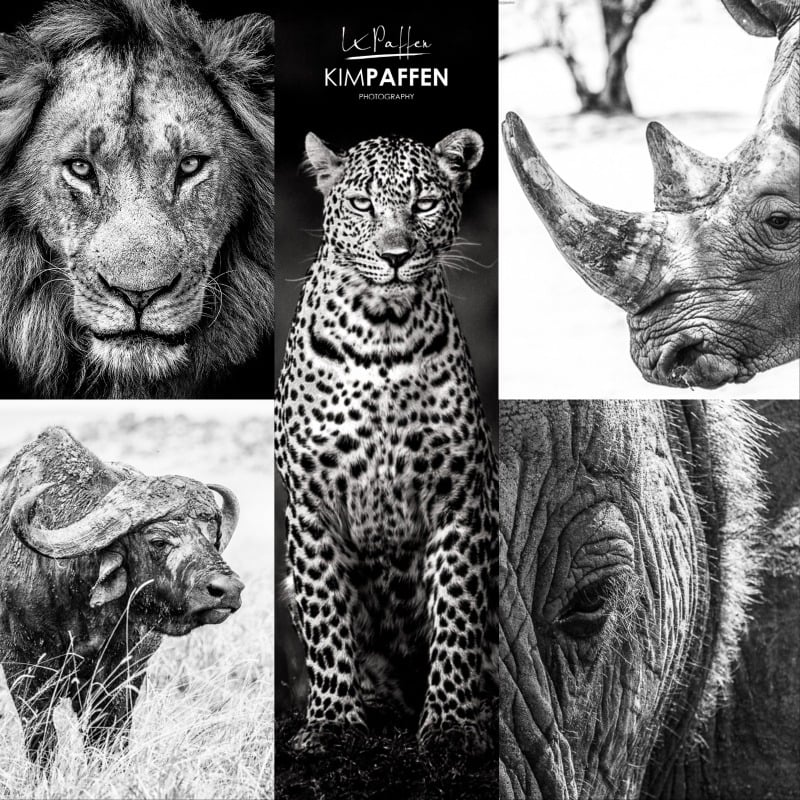
1. African Elephant: a gentle giant
The African savanna elephant is the largest land mammal in the world and can reach up to 3 meters in height and can weigh up to 7 tons. The African forest elephant is 3 feet shorter. Elephants communicate across a large distance at a very low frequency through their feet and the soil that cannot be heard by humans. Elephants live in a herd that is led by the 'matriarch' female. The elephant is threatened by ivory poachers for their tusks.
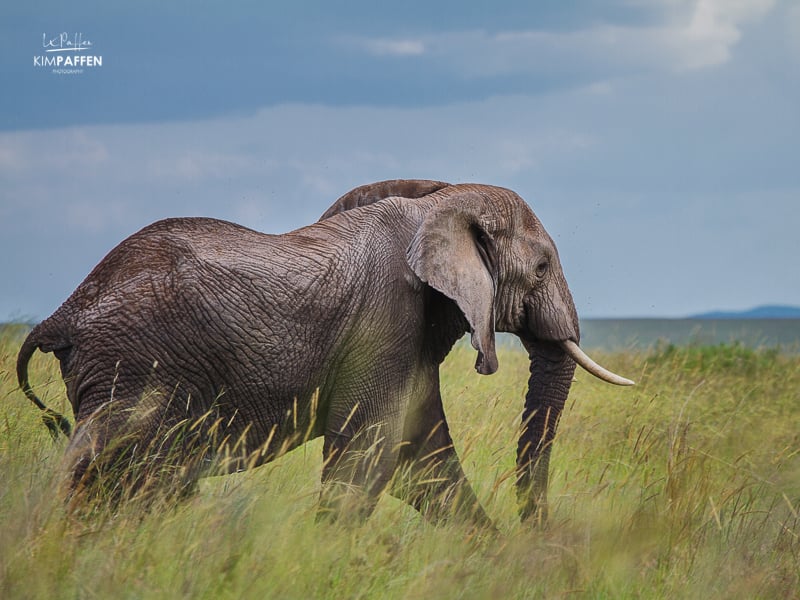
2. Rhino: most endangered species of the Big 5
The Rhinoceros is the most endangered species of the Big Five due to rhino poaching and illegal trade in rhino horns. There are two species of rhino in Africa: the White Rhino and the Black Rhino and five subspecies.
The names of the rhino don't have anything to do with color as both species are grey. The name of the 'white' rhino is a corruption of the Dutch word 'wijd' (wide), which refers to the wide mouth or square lip of the white rhino. A rhino can weigh up to 5000 pounds and its horns can grow up to 5 feet long. Rhinos have poor eyesight but excellent hearing and sense of smell.
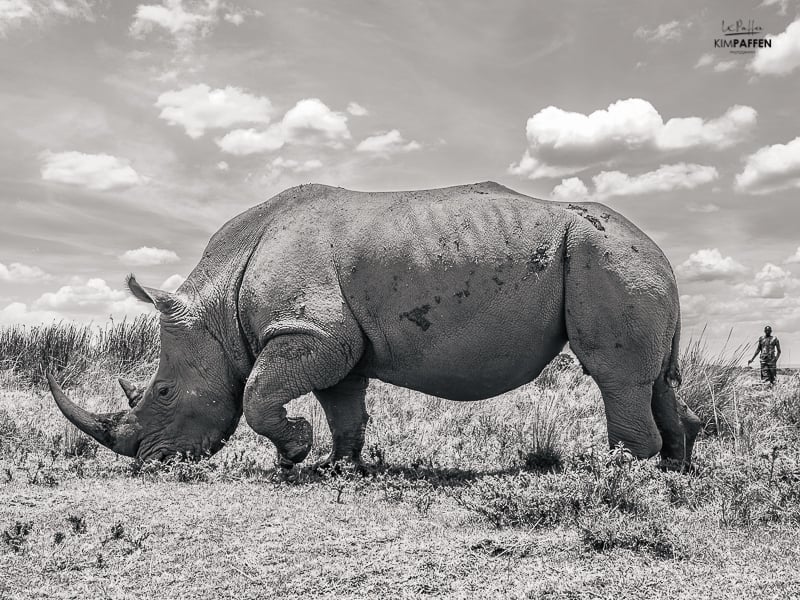
3. African Lion: courageous King of the jungle
An African lion is the largest predator on land. Preys of the lion include zebra, impala, giraffes, and other herbivores like wildebeest. A group of lions is called a pride and males are easily distinguished from females because of their large manes. The darker the lion's manes, the older he is.
A male lion is sometimes referred to as the king, but in reality, lions don't have a permanent social hierarchy. The dominant male in a lion pride can change at any time. The females hold the territory and stay with the pride in which they were born. They also do most of the hunting and take care of the cubs. Lions use their roar as a form of communication and can be heard up to 5 miles away.
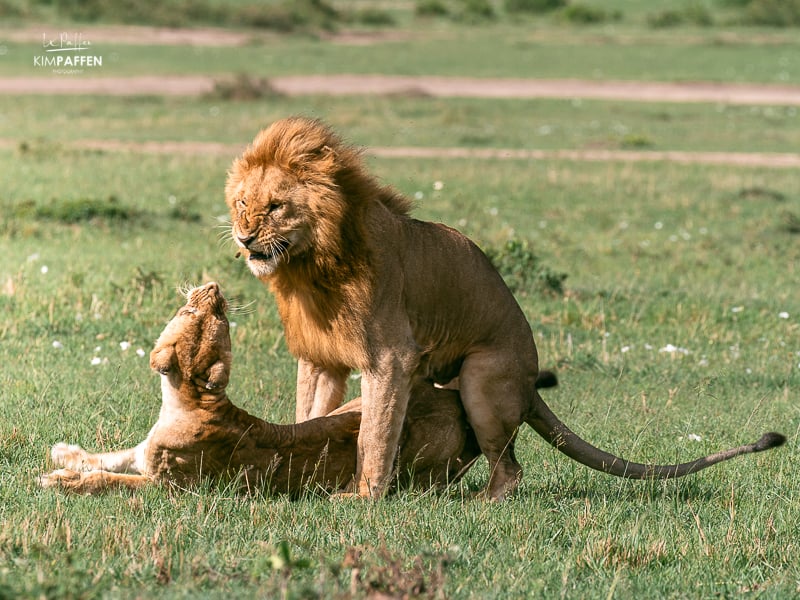
4. Leopard: sneaky and excellent tree climber
The African leopard is the most solitary and elusive animal of the big 5, staying hidden during the day. They are the least seen of the Big 5 and on most occasions found alone. The leopard is nocturnal and mainly hunts at night. Their kills include zebra and antelopes like Thompson Gazelle. The elusive leopards hide their prey in a tree to prevent lions and hyenas from stealing it. A lion and a leopard both belong to the African big cats, but they can't get along. A lion will kill a leopard if it has the chance. A leopard is also a good swimmer and occasionally eats fish.

5. Cape Buffalo: most dangerous to humans
The African buffalo is very territorial and protective and is probably the most dangerous animal of the big five to humans. If this cow-like animal feels threatened it can become very aggressive and charge with astonishing speed. Buffaloes are mostly found in groups and large herds and spend a lot of their time grazing. Both male and female buffaloes have horns, but the males' horns curve and come together in the center, forming a big bony plate called a boss.
The primary predator of the buffalo is the lion. A buffalo will try to protect and rescue another member of the herd and they have even been seen killing a lion after the lion had killed a member of the group. Although the African buffalo and water buffalo resemble each other, they are not closely related.
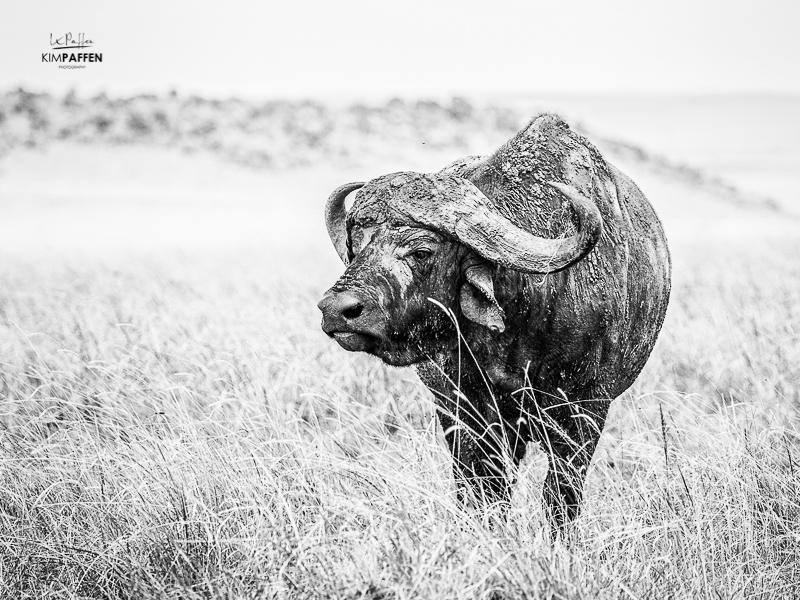
The Big 5 animals live on the African continent. You can find all of the Big 5 in Southern Africa and East Africa. The African countries where you can see the Big Five are:
- Democratic Republic of the Congo (DRC)
- South Africa
Not all of the above countries where the Big 5 live are ideal for a safari trip in terms of safety and existing numbers of the Big Five species.
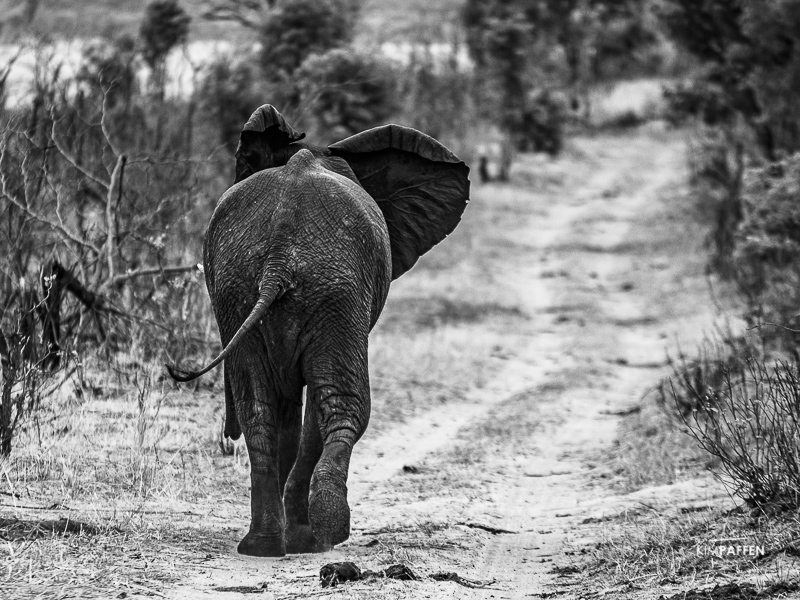
The best countries to see all the big five on safari are South Africa, Kenya, Tanzania, Botswana, Uganda, and Namibia.
However, in Namibia, you can't find all of the Big 5 in one place. In Etosha National Park you can only see 4 of the African Big Five. You can't find the buffalo there, but it's the best place in Africa to see the black rhino. They often concentrate around a water hole where tourists can sit to observe these critically endangered animals.
In Uganda, you can't see rhinos in the wild, but you have a chance of seeing all the Big 5 when you visit them up close at Ziwa Rhino Sanctuary where they roam freely but are protected by rangers 24/7. In Uganda, you can also see the endangered mountain Gorilla and our closest relative on a chimpanzee trekking or chimpanzee habituation.

South Africa is one of the most reliable Big Five safari destinations to spot all the Big 5 . South Africa even honored the importance of the Big 5 animals by putting each of the 5 animals on their bills.
The best chance of seeing the Big Five on a single safari or even on a single game drive is at the following places:
- Kruger National Park and the surrounding reserves, like Sabi Sand Game Reserve . Kruger is one of the best places to go for a safari in South Africa for both beginner safari travelers and seasoned wildlife viewers. Sabi Sand hosts luxurious safari lodges and shares an unfenced border with Kruger with an abundance of wildlife roaming around freely. It's also known for its high number of leopard sightings.
- Shamwari Private Game Reserve is a great place to find the Big 5 in South Africa. A beautiful high-end reserve with luxurious lodges and an exclusive feeling. You're often the only safari vehicle at an animal sighting. Shamwari is also well-known for its wildlife conservation initiatives, like the born-free Foundation.
- Ngorongoro Crater in Tanzania is a perfect place to find all of the Big Five in one day and you can combine your trip to the Ngorongoro Crater with for example the Serengeti which is famous for its wildlife sightings including the great migration of wildebeest and zebra.
- Maasai Mara National Park and the Mara Conservancies are also one of the best places to find the Big 5, although seeing rhinos roaming freely is a challenge. Some conservancies have a rhino sanctuary, but these rhinos are protected by rangers 24/7. An example is the Enonkishu Conservancy on the northern boundary of the Maasai Mara Conservancies. Another great place in Kenya to see rhinos is at Ol Pejeta Conservancy.
Of course, there are much more places and national parks to see the Big Five. Not all national parks have all of the Big Five and when they do have them, it can be harder to spot all of them on a single safari in Africa.
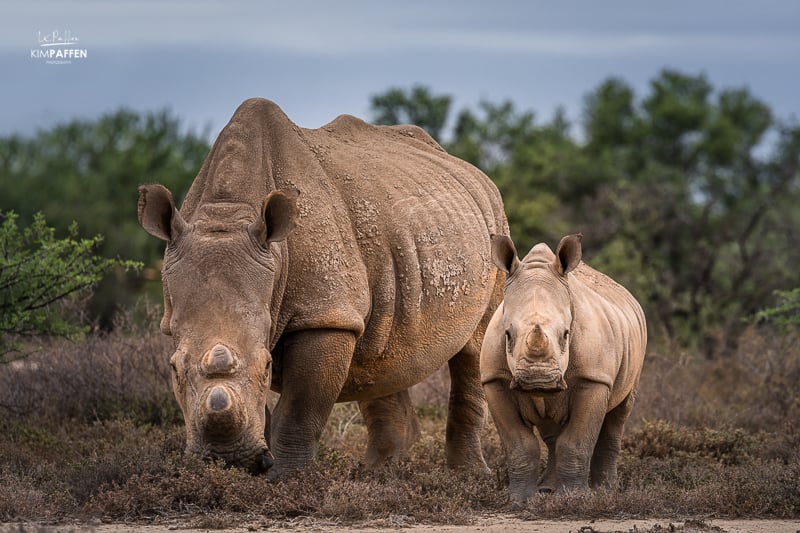
The high season for a safari in Africa is from July to October . It's the cooler dry winter which makes a Big 5 sighting easier because of the thin and dried-up vegetation. The lack of rain also means animals congregate around flowing rivers or larger lakes to drink. However, the shoulder seasons are also perfect to find the big 5 in Africa and it's less touristy.
Africa's Big Five are of great concern for wildlife conservationists due to trophy hunting, poaching, and habitat loss. Most of the Big 5 animals are listed as vulnerable or (critically) endangered species by the International Union for Conservation of Nature (IUCN). Hunting is sadly still allowed to some degree, but Africa now also has strict laws to protect and conserve many African animal species.
The black rhinoceros is classified as critically endangered and the southern white rhinoceros is near threatened. Mostly due to poaching because of the rhino horn. Two species of the African Big Cats , the African lion, and the African leopard are classified as vulnerable. The African savanna elephant is an endangered species, mainly because of the poaching crisis and habitat loss. The African buffalo is of the least concern of all the Big Five animals.
Contributing to wildlife conservation
The African Big 5 animals and other endangered species are widely protected in National Parks and government-run game reserves; partnering with the surrounding communities to reduce the human-wildlife conflict. Tourists contribute directly to big 5 wildlife conservation by going on safari in Africa and paying park fees.
As a nature and wildlife photographer, I also give back to wildlife conservation by donating 10% of each Fine Art Wildlife Photo Print sold in my webshop to the education of guides and rangers as a long-term goal to change the world and to protect our wildlife from extinction due to wildlife crimes and habitat loss. By buying a print in my webshop, you can make a difference too!
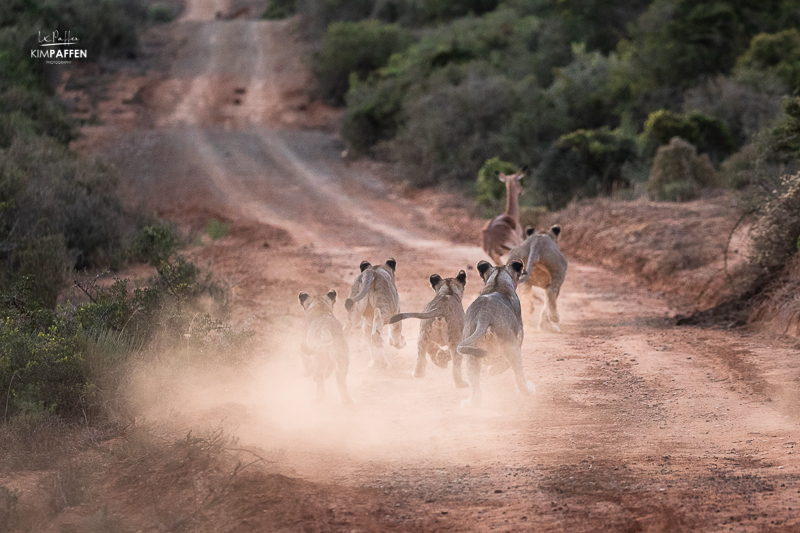
Apart from having the Big 5 in Africa, there are also other animal combinations formed that include 5 African animals. Africa also has the Shy Five and Little Five . It even named the Ugly Five , but that is very subjective.
Did you know I'm a qualified Field Guide (also known as a nature guide or safari guide )? I'm more than happy to take you on a photo safari to Africa with me where you will learn even more about the Big Five and all other flora and fauna. As a photographic tour leader and Dutch/English/German-speaking tour guide, I work closely together with local African tour operators and local drivers/guides. Get in touch to enquire about the possibilities.
I hope this article was helpful to learn more facts about the African Big 5 animals , including why they are called the Big Five, in what countries these Big 5 safari animals are found, and the best time of spotting them with a side note that there's more to Africa than spotting the Big Five.
Smaller creatures play an important role in the ecosystems as well. People who are going on a safari in Africa shouldn't be disappointed when they don't tick off the Big Five. Try to appreciate every single animal, big or small. Even trees, plants, and flowers. Every sighting is a gift of nature. Everything is connected and we should appreciate this more.
You would help me a lot by sharing this guide to the Big 5 in Africa on your social media or pinning it on Pinterest for later use.
Want to keep up to date with my travels? Follow me on Instagram @ourplanetinmylens. If you are inspired to go on a safari to Africa, you can find all of my writing about Africa and its countries in my Africa Travel Guide .
Pin the Guide about the Big 5 animals on Pinterest!
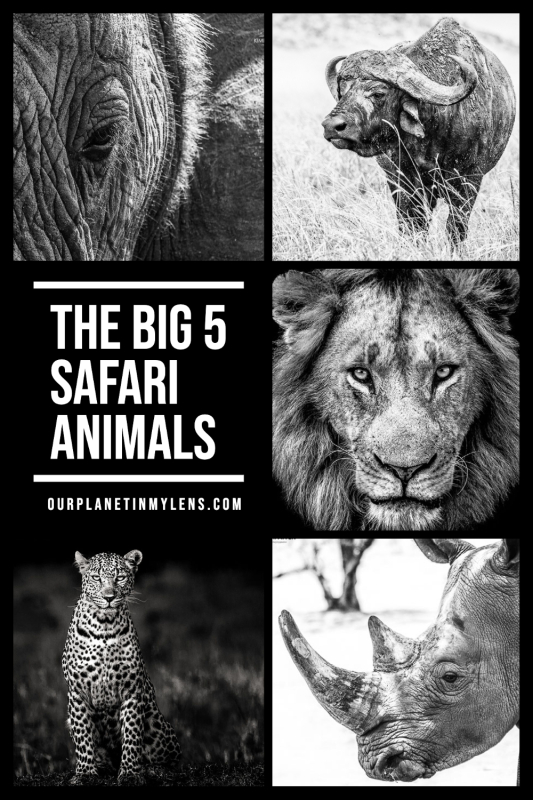
- 1x Each Month! A newsletter with free photography & travel tips to help you make the most out of your trip
- Be the first to know about giveaways, for instance, free ebooks and downloadable travel images
Yes, I want to receive the newsletter 1x p/month

Wildlife Encounters: The Big Five and Other African Animals

A vast continent rich in biodiversity, sweeping savannahs, ancient indigenous culture, lush jungles and amber deserts, Africa’s unique magic has captured the hearts and souls of adventurers and dreamers alike for centuries. At the core of the continent’s allure is its magnificent wildlife and vast open spaces, offering some of the most breathtaking and unique animal encounters on the planet. Africa's wildlife is a living testament to nature's intelligence and adaptability. The Big Five - elephant, lion, leopard, buffalo and rhino - are often considered the pinnacle of Africa’s rich tapestry of wild creatures, although every animal sighting is a gift and no less fascinating. These animals, topping the must-see lists of wildlife enthusiasts, are not just symbols of the wild and keystone species, but also vital barometers of the health and vitality of their ecosystems. Let’s explore the enigmatic world of the Big Five, unravel their habits and mysteries and introduce you to some of the other wonders of African fauna. As we embark on this journey, we'll also underscore the critical importance of preserving these treasures of the wild for generations to come.
An Exploration of the Big 5 African Animals
Of all the wildlife that call the open grasslands home, the African Big 5 animals are the most iconic. While elephants, rhinos, leopards, lions and buffalo are vastly different creatures, they all thrive in the same wilderness environments across multiple countries in Southern and East Africa. The origins of the term “Big Five” can be attributed to the big game trophy hunters of the 19th and 20th centuries. The mammal species included in the term were known to be particularly dangerous and difficult to hunt. Fortunately, the days of widespread trophy hunting are behind us though threats to wildlife have sadly evolved to include illegal poaching, human-wildlife conflict and habitat loss. At ROAR AFRICA, a breathless urgency to save the wildlife and wilderness we have left is central to everything we do and the Big Five are a core focus of conservation across the continent, widely celebrated for their magnificence. It’s no surprise that witnessing these iconic animals roaming free in their natural habitat on an African safari is a bucket-list dream for so many curious travelers, photographers, conservationists, ecologists and wildlife enthusiasts around the world. There is simply nothing like it. Let us take a closer look at what makes each of the Big 5 African animals so unique.
The King of the Jungle
The African lion is one of the most revered animals in the world. This big cat is the epitome of regal power, pride, resilience and intelligence. The commanding presence and majestic manes of male lions embody the apex predator of the savannah. In each measured step and thunderous roar, the African lion embodies a fierce protectiveness over the pride and determination to dominate and survive. Viewing the pride of lions in their natural habitat invites travelers to see the eternal daily dance between predator and prey in the vast wilderness. One also sees the more tender and playful moments between mothers and cubs, a reminder that we’re not so different after all.
The Gentle Giants
Nothing can prepare travelers for the sheer size and sensitivity of the African elephant. The largest animals to walk the Earth can be found throughout the continent. Guided by the family matriarch, these herds traverse ancient migratory routes that cover hundreds of miles across the expansive bush in search of food and water.
Critically endangered African forest elephants are smaller and more elusive. Given, that these mammals thrive in the humid, tropical forests rather than the savannahs, you’ll find forest elephants in the thick jungle terrain of Central and West Africa. Elephants’ intelligence and capacity for emotion are so similar to humans - they feel love, loyalty, joy and sorrow just as we do and will do anything to protect their young. These gentle giants are a true testament to a life lived in harmony with the land. Through their ancient migratory travels, the elephants act like architects of the landscape, spreading seeds and carving divets in the ground with their heavy feet for rainwater to gather. These actions are critical to biodiversity and the continuing health of the ecosystem. Elephants have shaped Africa and its flora and fauna as we know it today.

The Formidable Bovine
One of the most iconic African horned animals is often heard before it’s seen. The thunderous hooves of a stampeding buffalo herd echo across the vast expanse shooting up clouds of dust. Although buffaloes have a majestic and formidable presence, these creatures are considered one of the most dangerous African animals, but it’s perfectly safe to view these herds from game vehicles or the air by helicopter.
The Master of Stealth
The elusive African leopard is a shy, nocturnal enigma across sub-Saharan Africa. While so many African animals rely on sheer size and sound for survival, the solitary leopard embodies a quiet strength and dexterity that cannot be matched. This big cat has mastered the art of concealment but can still be found on safari defying gravity atop the trees, resting in the grasses or chasing prey through the bush at lightning speed.
The Armored Tank of the Savannah
Last, but certainly not least, is the rhinoceros. Of the two main rhino species (black and white), the black rhino is unfortunately the most endangered of all the African Big 5 animals with numbers steadily plummeting due to chronic poaching for its horn - which is mistakenly believed to have medical benefits. However, collaborative conservation efforts and translocations are helping to protect populations of both black and white rhinos in national parks and preserved areas.
As the rhino's fate hangs in the balance, sustainable tourism , education and extreme conservation efforts are the key to preserving this resilient keystone species.
Where Can You Find the African Big 5 Animals
These African animals can be found throughout the continent, but there are few places where they coexist. Kruger National Park is perhaps the most popular destination where all these South African animals (and more than 140 other species) can be seen on safari.
Serengeti and Ngorongoro Crater in Tanzania, Lake Nakuru in Kenya and Chobe National Park in Botswana are other areas where the African Big 5 animals coexist.
Beyond the Big Five: Other Notable African Wildlife
Africa is the world’s second-largest continent. A land of endless contrasts, you’ll experience incredibly diverse landscapes that are home to thousands of wildlife species. Many of these extraordinary animals can only be found in Africa. From the world’s largest mammal to the tallest, here are some more iconic animals in Africa you can see up close on safari.
The Memorable Small 5
Along with the Big 5 African animals, there are also the Small Five. This includes some of the continent's smallest creatures that have more impressive namesakes: the rhino beetle, buffalo weaver, ant lion, leopard tortoise and elephant shrew. While Africa’s Big 5 are iconically impressive, the Small 5 are also incredible to behold and are just as critical to maintaining the fragile ecosystem that makes up the circle of life. Taking a bush walk with an experienced guide brings you closer to the land and to these smaller creatures that are often very rare and special to see.
A Bird’s-Eye View
Africa is a bird-watchers paradise. From the smallest warbler to the stunning herons and vibrant flamingos, there are endless species to be found. It’s these multitudes of smaller marvels, such as bird migrations , that enthrall travelers. And for the novices, once you witness the bright flecks of color and shimmering feathers of Africa’s native avian species, you can’t help but fall in love, keeping your eyes on the trees and the skies in search of these beautiful birds in flight.
Our Closest Cousins
In the jungles of Rwanda and Uganda live some of our closest animal relatives who share up to 97% of our DNA. Chimps, gorillas and monkeys live peacefully nestled deep beneath the dense rainforest canopy thanks to robust conservation efforts and responsible tourism.
Gorilla trekking is a highly rarefied experience, but one that is truly unforgettable and can be made accessible to anyone over the age of 15.
African Savannah Animals
Of course, we cannot forget to include other iconic African animals. The long necks of giraffes softly silhouette against the setting sun. A cheetah masterfully chasing prey through the savannah. These animals and many more, are what bind the ecosystem together.
On a luxury African safari, you have the opportunity to see the Big 5 animals and so much more spanning from African wild dogs, hippos, wildebeest…the list is truly endless.
Explore our luxury African destinations and the African animals that can be found there at ROAR AFRICA.
Subscribe to receive the latest updates

Contact Details
Connect with us, press inquiries, general inquiries.


Big Five Animals | Facts About These Iconic African Mammals
Are you familiar with safari animals? And no, not the ones searched on Apple web browser. If you’ve ever been to Africa, you’ve definitely heard about the iconic Big Five animals.
The Big Five includes lions, elephants, buffalos, rhinos, and leopards. These groups of mammals are incredibly popular in game reserves and safari tours. The term ‘Big Five’ first came into use to describe and identify the five most difficult animals to hunt by foot.
Nowadays, the term is more ubiquitous, as the Big Five are much-loved, valued, and protected. Although it is still legal to hunt the Big Five, the bounty is much pricier. And given the possible extinction of some of these glorious animals, it is much better to observe them at African safaris resorts or game reserves.
If you’re interested in learning more about the Big Five, stick around.
A Closer Look at The Big Five
Time to dive deeper into each Big Five animal, from their characteristics to where you can find them.
The African Lion

The lion is arguably the most famous of The Big Five animals. Popularly referenced as the “kings of the animal kingdom,” lions sit atop the animal food chain.
These felines can weigh up to 550 lbs and are superb hunters. Lions can eat as much as 15 lbs of meat in one sitting or 15% of their body weight. Lions kill their prey with a bite to the neck or clamping their jaws around its throat until it suffocates.

Lions are social animals, so naturally, they hunt in groups, with a pride of lions ranging from 2 to 40 members. Their cubs are also raised in groups and are almost always reared by the lionesses.
Contrary to popular belief, lions do not stay in the jungle. There are two recognized species: the African lion which lives south of the Sahara Desert , and the central/west African lion. A small population of the Asiatic lion can also be found in western India.
Read more: Learn more about the hunting difference between lion and lionesses .
The African Elephant

Elephants are the world’s largest land animals, so it’s no wonder they are a part of the Big Five. But don’t let their mammoth size scare you. These creatures are as gentle as they come – unless provoked.
Elephants have many distinct features, including their ears, trunks, tusks, and brain.
Elephant ears are remarkably huge. Interestingly, you can tell elephants apart by the shape of their ears. African elephants (which have a spot on the Big Five) have much larger ears with a similar shape to the African continent. Indian elephants, on the other hand, have smaller and rounder ears.

Ever heard the phrase, “an elephant never forgets?” Well, there’s some truth to that. Scientific studies suggest that the part of the elephant’s brain associated with memory (the temporal lobe) is considerably bigger than humans. Impressively, an elephant’s brain can retain all memory from birth until death.
Elephants use their trunks for many purposes. They can grab objects, crack open fruits and nuts, drink water, and trumpet with their trunks. It’s no surprise that trunks are an elephant’s strongest organ, with a whopping 15 000 muscles.
The African Buffalo

The Cape buffalo is the largest bovine in Africa. These weighty cow-like mammals can reach up to 11 feet in length and can weigh anything between 660 lbs and 1900 lbs. This is not surprising, as these herbivores feast on 24 lbs of grass, shrubs, and aquatic plants daily.
Interestingly, Cape buffalos kill more hunters than any other species. They are also known to kill lions. Although they have poor eyesight and hearing, the African buffalo’s acute sense of smell makes for excellent defense. Their moody behavior and ability to charge without warning make these unpredictable creatures extremely difficult to hunt.

The Cape buffalo’s most distinct feature is its horns. The horns help determine these enormous bovine’s age and sex. The older the buffalo, the larger the horns.
Large adult males have horns that meet in the middle of their heads. This dense shield is called a “boss.” The Cape buffalo uses their horns for defense and to display dominance while mating. Female Cape buffalos have narrower and smaller horns.
Tip: For an up close and personal view of the African buffalo in South Africa, check out the South African safari guide .
The Black Rhino

Black rhinos have a misleading name – they aren’t actually black. Their skin is, in fact, gray and very sensitive to the harsh African atmosphere. Their skin also gets sunburnt pretty quickly. Sunscreen anyone?
Black rhinos are the third biggest rhino species. They can weigh anything between 1,760 lbs and 3,090 lbs. Their diets consist of a staggering 220 types of plants, and their big appetite contributes to their large bodies.

Black rhinos are most common in wetlands. Their habitats always have access to water sources like ponds, lakes, or rivers.
Herds of black rhinos can be found throughout southern and eastern Africa, from Kenya down to South Africa. Once an almost extinct species, rhinos currently have a population greater than 5000.
The Leopard

To close off the list, we have another feline – the leopard. You can find them across sub-Saharan Africa, Central Asia, India, and China. They have varying natural habitats, depending on the species.
African leopards are usually a pale yellow to deep gold hue. Their fur is covered in spots called “rosettes” because of how they resemble the shape of a rose. They are incredibly fast-paced and can reach speeds of up to 35 miles per hour.

Leopards are nocturnal, which means they hunt at night. When not ferociously hunting for prey, you’ll find leopards resting on grass or camouflaged in a tree.
Like most cats, leopards are solitary creatures. Leopards enjoy their alone time so much that they even hunt individually. When hunting, leopards go into stealth mode. They move cautiously before making an ambush with a fearsome bite to their prey’s neck.
Frequently Asked Questions About The Big Five
Time to answer some of the burning questions you may have about the Big Five.

Where Can I Find The Big Five?
You can find the Big Five across central, eastern, and southern Africa. Countries with some or all of the Big Five animals include South Africa, Namibia, Botswana, Zimbabwe, Zambia, Kenya, Tanzania, and Uganda.
Why Aren’t Hippos Part of The Big Five?
The Big Five does not necessarily include the biggest known land animals. If it did, hippos would definitely be considered a Big Five animal. Although hippos are dangerous and have a kill count higher than any other Big Five animal, they aren’t among the most challenging to hunt.

Why is The Big Five Only in Africa?
The Big Five animals require specific habitats. Africa has great weather, expansive vegetation, and a variety of prey. All these factors make the African continent the perfect home for the Big Five.
Do The Big Five Roam Around the City in Africa?
The Big Five are incredibly dangerous, so they cannot roam the streets of African cities. Like any other country, wildlife is secluded from the inner city. In most cases, you’ll find the Big Five wandering around in private game reserves.

Are Game Reserves Safe for The Big Five?
Because the Big Five are highly sought-after, they are extremely vulnerable to extinction. Enclosing the Big Five animals in game reserves is a great way to conserve and protect them. In a game reserve, the Big Five animals are within a controlled environment, which minimizes the danger of being hunted excessively.
Final Thoughts on The Big Five
The Big Five are incredibly interesting animals. They’ve even appeared on old South African bills. Ultimately, each animal represents the beauty and unpredictable nature of the wild.
If you enjoyed reading about the Big Five, you might want to check them out in real life. There are tons of all-inclusive African Safari vacations to choose from. Whether it be at the Serengeti or the Kruger National Park , the perfect safari experience awaits.

Tanzania Beach and Safari Holiday Packages | Tour Africa in Luxury

Top Animals in Masai Mara National Reserve | Mammals & More

Top Animals in Amboseli National Park | Mammals, Birds & More
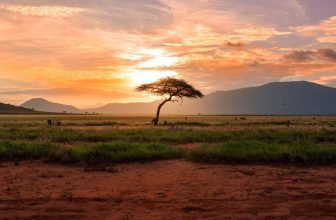
Top Animals in Chobe National Park | Mammals, Reptiles & Birds
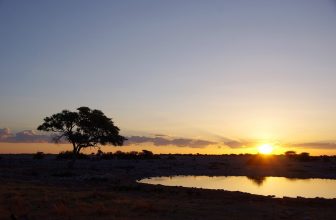
Top Animals in Etosha National Park | Mammals, Reptiles & Birds

Top Animals in Serengeti National Park | Mammals, Birds & More
Leave a reply cancel reply.
Save my name, email, and website in this browser for the next time I comment.

Compare items
- Total ( 0 )
Shopping cart
BIG discounts coming up in 2024! Get on the e-mail list for priority access & consideration.

BIG 5 African Animals
If you have ever done any slight research about African Animals - especially for a safari holiday, you have met the phrase of ' Big 5 ' referring to animals.
In this article, we shall look at what the big-5 actually means, as well as where you can find all the big-5 animals on an African safari.
While the phrase has become a staple in marketing wildlife safaris, its origins are in the hunting of wildlife. The term was coined by big-game hunters as a reference to the most difficult animals to hunt on foot.
The big-5 game animals are comprised of Rhinocerous, African Elephant, African Lion, African Leopard, and the Cape Buffalo.
Let us look at the animals in slightly more detail.
Africa's Big 5 Animals
1. african elephant.
The African Elephant is the biggest land animal in the whole world. From their big ears, precious tusks, dexterous trunk, and famed intelligence, elephants are fascinating and interesting to watch.
Except for young elephants, the only threats to an elephant are humans and in some rare instances lions (especially in Botswana). This doesn't make their future guaranteed because the biggest problem is shrinking habitat and the reduced food that comes along.
With their 5 kilogram brain, elephants are considered to have the best memory and when you get to see them, make sure to remember that moment because they sure won't forget you.
Related articles: 22 fun facts about the African Elephant Where to see African Elephants in the wild
2. Cape Buffalo
The African buffalo - also called Cape Buffalo is one of the more surprising African wild animals. Whereas it looks so close to the domesticated cows, it is one of the most hot-headed animals with a very unpredictable temperament.
Some estimates predict that cape buffaloes kill or trample around 200 people every year in Africa. While the numbers differ with each country, African buffaloes are not to be messed with.
The general rule of thumb is don't get too close.
Buffaloes are predominantly found in the savannahs of Southern and Eastern Africa but the smaller forest variety can be seen in DRC and some other places of central and western Africa.
Related article: Interesting facts about the African Cape buffalo
The lion is probably the most well know of all wild animals in the whole world. While lions are currently living in limited places - mostly in Africa, their history with humans is deep in communities all over the world.
A lion is feared, loved, and respected by most people because of its abilities. This is why it is called the king of the jungle or more correctly the king of beasts. Tanzania has the highest population of lions in the Serengeti but lions can be seen in many more countries.
Related articles:
- Where to see lions in the wild, in African national parks.
- Fascinating facts about Lions
Leopards are very solitary and are not very easy to see on safari. Their spotted body helps leopards to blend into their surroundings and hibernate all day without being noticed.
Like Rhinos, leopards face a threat of poaching. Leopards are poached for their colourful skin and other body parts as trophy possessions.
Leopards mostly move at night when they are going to hunt and usually live solitary lives. Leopards carry their hunted meat up a tree to avoid disturbing hyenas.
In most places, early morning or evening safari game drives are the best options to see a leopard and the sight is always humbling.
Related article: 14 Interesting facts about leopards
5. Rhinoceros
The name "Rhinoceros" is derived from greek - to mean 'nose-horned'. Rhinos face extinction and their survival has suffered due to the illegal wildlife trade for their horns.
In some Asian countries, the rhinoceros horn is believed to possess some healing powers and this has increased the demand for this rare animal. Rhinocerous horn is made out of the same material as human hair and fingernails, but this hasn't kept its price low. A kilogram of rhinoceros horn is as valuable as gold on the black market.
Besides all the groom that surrounds the life and survival of rhinoceroses, seeing them in the wild is a moving experience.
Related article: Fascinating facts about rhinos
Where To See The Big-5 Animals
After knowing a little bit about the big-5 game, it is now time to look at some countries where you can actually find all the animals.
Most countries in Africa have some of the big-5 animals but we'll look at the places which have all the five- elephants, lions, leopards, rhinoceroses, and cape buffaloes.
Final Thoughts
While the big-5 game was initially popularised by wildlife hunters, it is now more associated with wildlife-viewing safari activities and has little to do with hunting.
Wildlife hunting is mostly prohibited all over Africa, except in a few isolated cases where culling is allowed by the governments to control the population of animals. As you can see from above, it is unlikely that a wildlife hunting call will be put out since all the animals are essentially reducing in numbers due to various factors.
Why are they called the big 5 animals & other FAQs
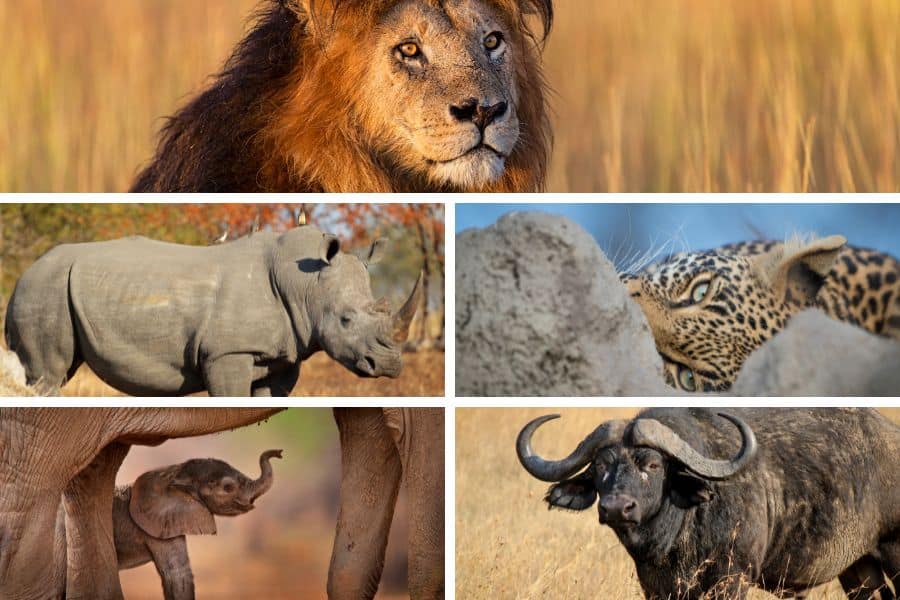
The “Big Five” is probably the most popular phrase in the African safari jargon.
More often than not, the first thing a safari newbie will tell you is: “I want to see the big five animals”. Almost as if it was the only thing “worthwhile” in the bush.
Or people will return from a safari saying, “I saw the big five”.
While this is the most popular term in the safari industry, it has a bitter history and makes the African savannah seem a very simple place.
So what makes them so “special”? And are they even the biggest?
In Africa, the big five safari animals are magnificent sightings . There are many fascinating things to know about these mighty mammals, so let’s find out more below.
What Are the Big Five Animals?

Can you name the big five animals?
The big five are the African elephant ( Loxodonta africana ), the African buffalo (also known as the Cape buffalo; Syncerus caffer ), the rhinoceros (Black rhino = Diceros bicornis ; White rhino = Ceratotherium simum ), the lion ( Panthera leo ), and the elusive leopard ( Panthera pardus ).
And no : they’re not defined as “big” because of their size. Otherwise, creatures such as the hippopotamus or super-tall giraffe would have made it on the list.
Why Are They Called the Big Five?
Historically, the big five got their fame because they were the most sought-after hunting trophies . And not just because their heads appeared most impressive after a visit to the taxidermist.
Simply put, the big five were the most dangerous African animals to hunt on foot . They’re very difficult to maneuver around and are highly unpredictable.
Most importantly, these five are the only animals that charge and fight back against guns .
So, as colonialists and aristocrats went around Africa with their gangs of servants, killing all five became the ultimate African hunting experience (even though the servants got killed first when an animal charged).
Why is There Still a Big Five Today?
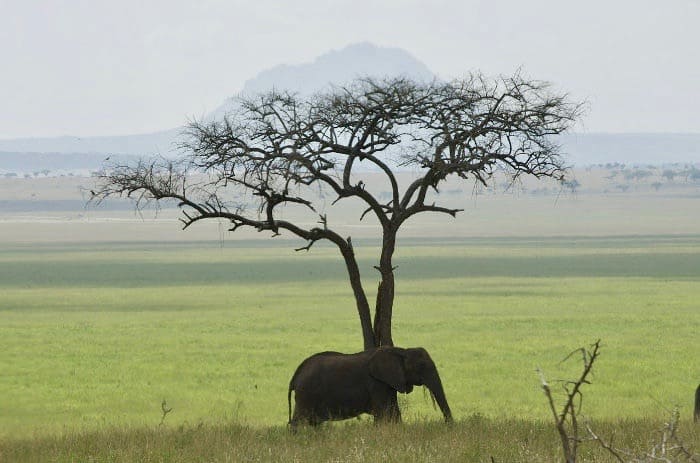
Many people don’t know about that history. They just hear the words safari and big five. Today, people idolize the term as much as ever , just for different reasons. Put simply, the big five sell safaris .
The term is extensively used in safari promotions and marketing . Expressions such as “Big 5 country” or “Home to the Big 5” have become common practices to attract tourists.
As the number of private game reserves has increased in the last 20 years, they are using the big five more and more.
It’s gotten to such an extent that people tend to ONLY want to see the Big 5 while often neglecting Mother Nature’s other hidden treasures.
It’s a pity as there’s far more beyond the big five animals to appreciate on a safari.
How the Big Five Simplifies the Safari Experience
If it’s your first safari, then it’s difficult to escape the desire to tick these five animals off your list . Almost everyone wants to say they went to Africa and saw the big five.
But what does that actually mean? That you get a glimpse of a leopard or rhino from 50 meters away?
Almost all private game reserves claim to have the big five. However, they might only have two elephants, one rhino, one lion pride, a leopard that is never seen, and a small buffalo herd.
In fact, that’s a pretty common scenario, especially for fenced private game reserves in South Africa .
In comparison, most of Africa’s BEST safari destinations DO NOT have the big five .
Chobe National Park has 100 000 elephants but no rhinos.
You can generally spot four of the five in Serengeti National Park or Masai Mara (black rhinos are seldom seen), but there are over 1 million wildebeest and zebras .
The Okavango Delta doesn’t have them all, nor does Samburu , Tarangire National Park or South Luangwa , Hwange , and many of Africa’s best safari destinations .
Thinking Beyond the African Big Five Animals
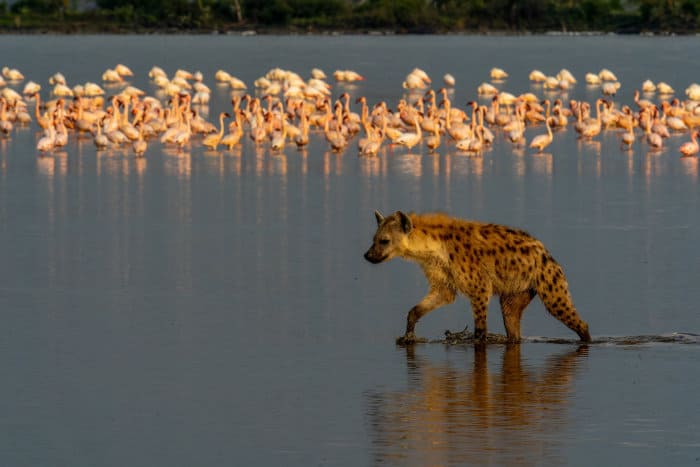
The best safari experiences aren’t planned . If you are only interested in five animals, then you’ll miss out on most of what makes Africa so special.
Safaris are about surprises . Intimate moments witnessed just by you, scenes of both drama and charm that carry you away.
You can see a cheetah chasing an impala across the savannah, loved-up zebra couples grooming each other, or lions meeting hippos at a waterhole.
You can capture the big five in photos. But the best part of a big five safari will be your personal moments with the animal kingdom.
That’s not a distant glimpse of a sleeping cat but coming face to face with thousands of wildebeest .
Seeing a rhino in the distance may sound exciting to some, yet it’s nothing compared to following spotted hyenas or wild dogs on a hunt.
Characteristics of the Big Five Animals
Now that you know which animals form the big five, let’s have a look at some fun facts and characteristics of each.
The African elephant

The African elephant is one of the most beautiful animals on Earth. It is also the largest land mammal on the planet , reaching weights of up to 6000 kg and heights of up to three meters.
Yet, the elephant is a fast runner . In fact, it is speedy enough to outrun most people ( > 40 km/h at full charge). Unless you’re Usain Bolt, of course. 🙂
African elephants are incredibly intelligent creatures and have amazing memory capabilities. These large creatures tend to stay together in matriarchal groups , consisting of grandmothers, mothers, daughters, and aunts.
Above that, they have an average lifespan of 70 years , so their great memory is quite necessary.
They are unmistakable with their imposing long “nose” (trunk), enlarged ears, and their precious “jewels” (tusks), which can grow up to around 2.5 meters. Regrettably, their tusks are often poached as trophies.
Did you notice they had ears in the shape of the African continent?
A fun fact about these giant mammals is that they have the ability to communicate over long distances at a low frequency, not audible to humans.
The best part is that they don’t use their big floppy ears for this communication, but rather their feet !
The African buffalo
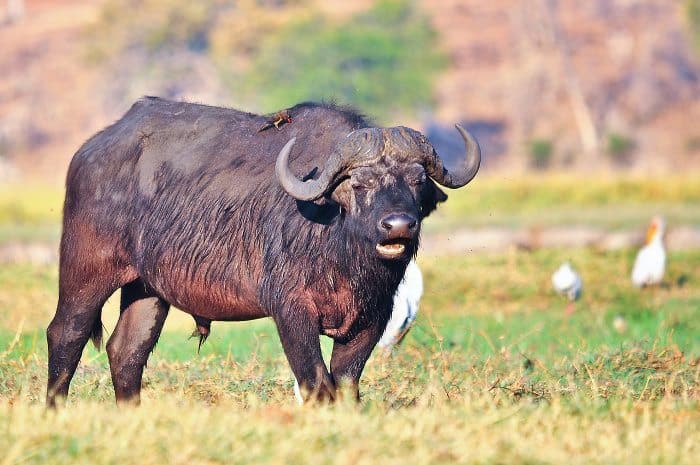
This is the most dangerous of them all, extremely feared by hunters. Cape buffaloes live in herds, but you’ll occasionally come across a solitary bull.
When on its own, the bull can be extremely aggressive when approached. They’re better left alone.
The African buffalo can weigh up to 1000 kg and is one of Simba’s favorite steaks!
Yet, they won’t go down without putting up a fight. Buffaloes protect and try to rescue another member of the herd if a lion catches them. They’re even known to murder a lion that’s killed a group member.
The rhinoceros
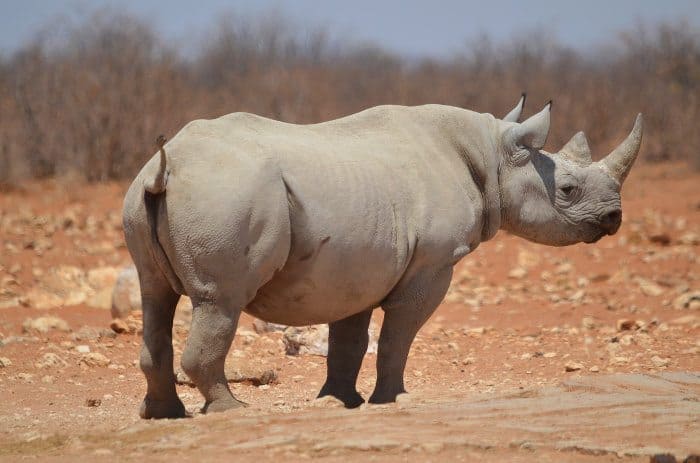
There are two types of rhinos in Africa: the black rhino with its distinctive prehensile lip (which makes it a browser), and the white rhino (not white at all), a typical grazer.
You’re probably wondering why it’s called a white rhino despite being gray or yellowish brown. The white rhino’s name comes from the Dutch word “wijd” — which means wide .
People used this word to describe the rhino’s squared lip . The word has nothing to do with its color. The black rhino, in contrast, has a more pointed upper lip.
Rhinos are also heavy creatures, weighing between 1000 kg (for the black species) and up to 2000 kg (white rhino). As with elephants, rhinos are widely poached for their horn — which can grow up to 1.5 meters long.
Hunters and poachers take their horns away as trophies — to make knife handles, for instance — or are sometimes used in powders (as an “aphrodisiac”).
In certain Asian cultures, people believe that rhino horn has various medicinal purposes , though this is completely false.
Their highly sought-after horns, unfortunately, make them the most endangered members of the African big five.
With poachers continuously employing more advanced methods to hunt these horns, it is very rare for a rhino to survive outside the safety of nature reserves and national parks .

This is Africa’s “King of the Jungle”. An animal of rare beauty, undoubtedly the most famous of them all.
The lion is a skillful hunter with incredible power and speed. Its eyesight is like no other, and it also has excellent hearing and a great sense of smell.
They’re apex predators and can hunt animals much larger than them. These include giraffes, impala, zebra, and the blue wildebeest .
Male lions are very recognizable with their long and imposing mane. Typically, a darker mane means that the male lion is older.
Lions are also highly social animals . In the pride, male lions eat first, yet it is the females that do “most” (if not all) the chasing and hunting.
Once the male has satisfied its appetite, the lionesses join the feast, while lion cubs have to content themselves with any leftovers.
The leopard

My personal favorite.
There are several interesting facts about leopards . Did you know that not a single leopard spot is exactly the same?
In fact, many biologists use the spot patterns on their face and neck to distinguish them from one another. To be honest, I wouldn’t be able to tell the difference. Well, perhaps I’d need a LOT of practice!
While on a safari, the leopard is always my top animal on the checklist. It has all the characteristics I love: it is graceful , an expert climber , and has extraordinary hunting capabilities .
They use their strong climbing abilities to drag prey into the trees, away from lions and hyenas. But they’re not only experts with trees. Occasionally, leopards will even swim and hunt small prey like fish or crabs.
In contrast with the lion, the leopard is very solitary and shy — and they’re nocturnal animals . This makes it even more rewarding and lucky if you “spot” them during the day.
They’re an absolute treat for the eyes.
Big 5 Africa: Video
Practical Tips for Choosing a Safari Destination (With or Without the Big Five)
There is no denying that the hunter’s relic is a marketer’s masterpiece . Alternative catchphrases don’t spring to mind. So while the big five is an outdated concept in one sense, it remains essential to the African safari industry.
When choosing a safari destination, our recommendation is to evoke the origins of the word “safari” instead. This is a Swahili word meaning “long journey” .
A long journey implies something unpredictable , moving the expectation away from five animals to a personal experience in the wild. After all, who wants the same five photos as everybody else?
By viewing a safari as a journey — rather than a “hunt” to see the big five — you can celebrate the individuality of the experience and destination.
You’ll make an African safari a subjective experience rather than an objective fact.
When you’re researching destinations, here are some considerations to make.
- Read reviews : Especially of private game reserves, as this will give you a good idea of what you’re actually likely to spot.
- Look at what makes the reserve or park unique : Rather than checking if it has the same standard five sights, see what other animals are unique to that region or park.
- Look up the size of the park : Larger wilderness areas usually have more diverse habitats and can sustain both greater numbers and greater diversity of wildlife. The more variety and animals in the park, the higher your chance of seeing the big five and more wondrous animals.
- Check whether it is a fenced park : Most national parks are not, but small, private game reserves need fences to stop the only rhino or elephant from leaving.
- Consider the quantity of wildlife : Encountering two elephants is beautiful but pretty standard in Africa. Seeing more than 200 on a single game drive is mind-blowing.
Looking Beyond the Big 5 African Animals

Hopefully, you now have a better idea of why this group of mighty animals is called the big five.
And, with some big five animal facts out of the way, you can move on to exploring more of the wondrous species in the African wilderness.
Other excellent wild animals to look forward to on your African safari include the striped zebra , the semiaquatic hippo , the leaping springbok , and so much more.
They’re equally as fascinating as the coveted Big 5, and you should not overlook them simply because they don’t form part of this commercialized term.
About The Author
Michael Theys
Related posts.
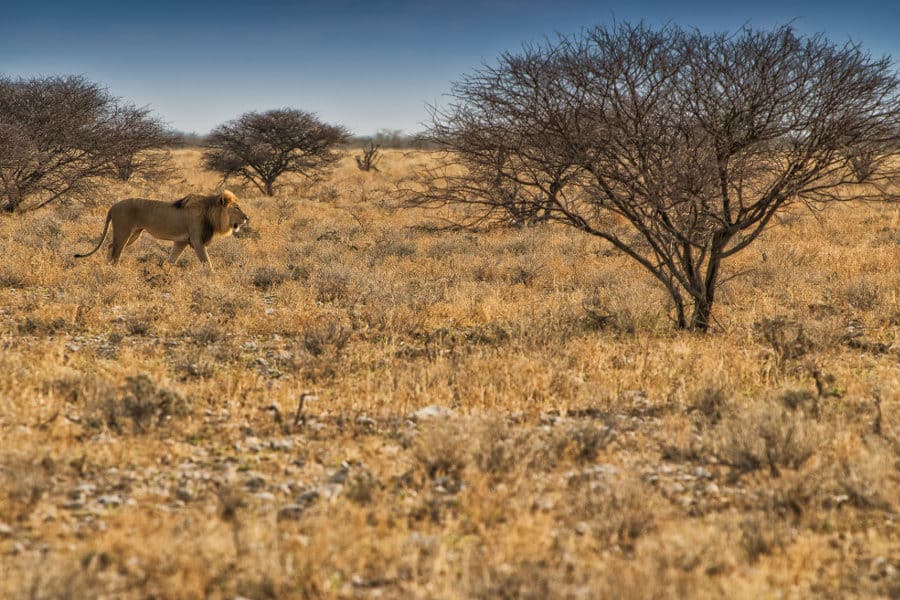

10 interesting facts about lions: cubs, hunting, roars & more
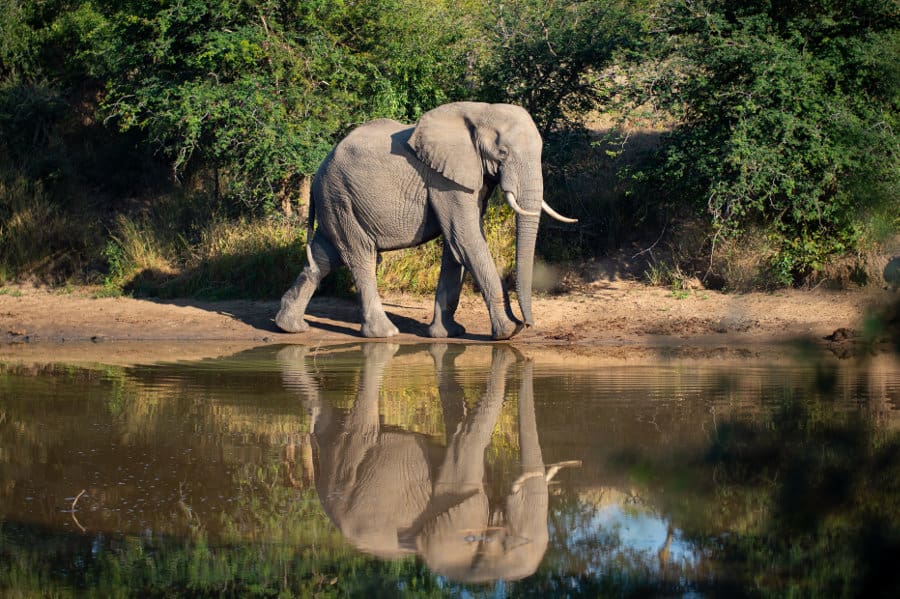
13 African elephant facts – Fun and interesting info on the savanna giant
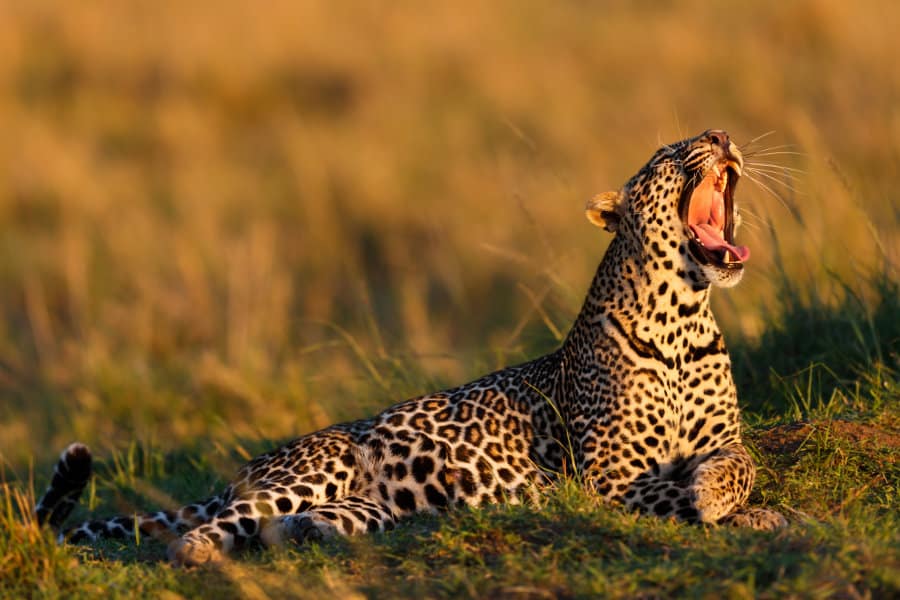
14 interesting facts about leopards
Leave a comment cancel reply.
Your email address will not be published. Required fields are marked *
The African Big Five: The Top 5 Animals to Spot on Safari
There are certainly a wide range of animals you can catch sight of during a safari in Africa (just check out my Safari Animal Bucket List to see how many!), but there are a handful that get the most adoration—the African Big 5—said to be the most dangerous animals to hunt on foot. If you are traveling to halfway around the world for an African safari there is little doubt that you will want to spot these Big Five beauties, which include the African elephant, leopard, lion, Cape buffalo and the every so elusive rhino.
In case you’re curious to learn more about the animals that belong to the Big Five, or at least which safaris to look further into if you want to specifically spot one or more of them, I’ve given some insight of each one and their natural habitats below.

The African Big Five are the Top 5 Animals to Spot on Safari
What is the big five .
The term “Big Five” was originally coined to refer to the animals on African Safaris that were the hardest and most dangerous to sport hunt. These Big Five animals were African elephants, Cape Buffalo, Leopard, Lion and Rhino. They’re still considered the African Big 5 today, although thankfully these days it’s more in terms of being the most sought after animals to see on a safari rather than to hunt down.
Meet the Big 5
African elephant.
The African elephant is the largest animal that walks on Earth (with the Antarctic blue whale being the largest animal on Earth overall). Two subspecies of the African elephant exist, with 37 of the countries in Africa having at least one subspecies—Savannah elephant and Forest elephant—roaming around their soil. African elephant’s status is considered vulnerable, with especially the Forest elephant suffering from poaching for their ivory.
WHERE TO SPOT IN AFRICA
African elephants are quite widely spread around the African continent, and your sure to see dozens while on safari. But even so, they are far easier to spot in some places than in others. For your best bet to spot an elephant during a safari, visit a safari in Botswana or South Africa, Amboseli National Park in Kenya, Tarangire National Park in Tanzania, or Damaraland in Namibia.

Cape Buffalo
Cape buffalo is a subspecies of the African buffalo, the one most commonly seen roaming about sub-Saharan Africa. They live in herds, with anywhere from 50 to 500 members, with any type of terrain being to their liking as long as there’s water nearby. During the rainy season, you may see a buffalo herd with thousands of members in Serengeti.
You can find cape buffalo in many areas across sub-Saharan Africa. However, just like with elephants, you’ll have a far easier time spotting a buffalo in some regions over others. Kruger National Park, Addo National Park and Hluhluwe Imfolozi game reserve are some of the best places to visit for a buffalo sighting, as well as of course Serengeti during the rainy season.
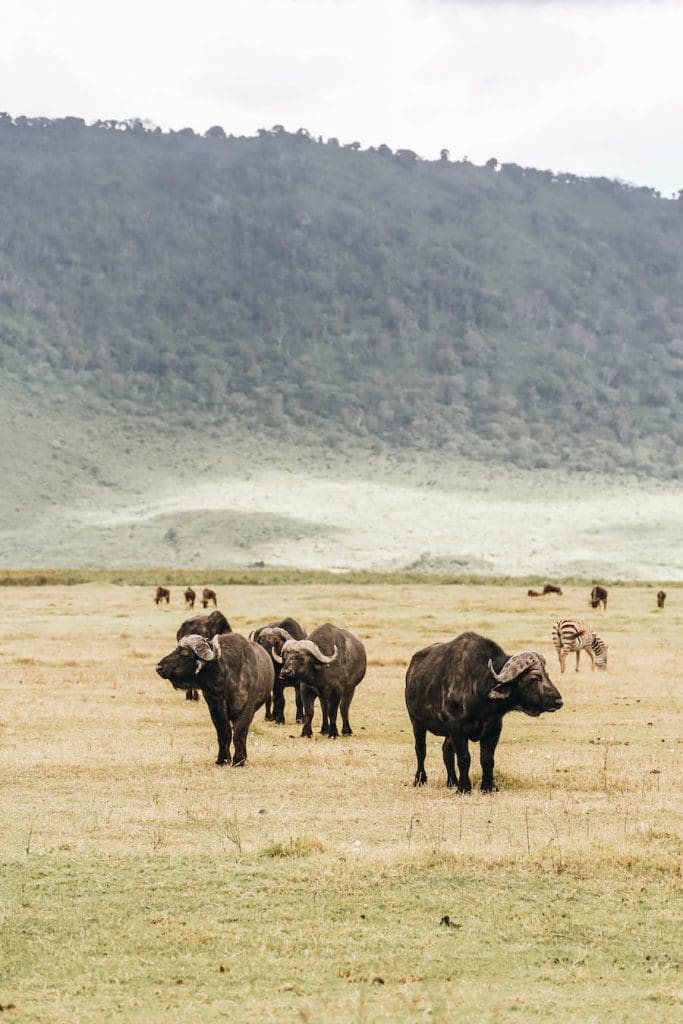
Found in northern Africa and sub-Saharan Africa, leopards are strong and stealthy big cat animals. They hunt predominantly by stalking their prey in the tall grass, but also feel comfortable and at home up in the trees or in the water.
Your best bets for a sighting of a leopard are in Kenya’s Masai Mara and Tanzania’s Serengeti, especially the latter’s Seronera Valley. You can also spot a leopard in other national parks and game reserves in Kenya, in Zambia’s South Luangwa National Park, in Botswana’s Moremi Game Reserve, and in South Africa’s Londolozi Private Game Reserve.

Another big cat, lions are the second largest cat in the world, living in various terrains in sub-Saharan Africa. Unlike other cat animals out there, lions are social animals living in prides of around 30 lions. One pride consists specifically of 3 males, a dozen females related to them, and the young of the pride, with males and females having their distinctive roles in the pride.
Depending on your interests, there are various spots to see lions in Africa. If you want to see a pride of lions that have taken a liking to water, head to Okavango Delta; in Chobe National Park, on the other hand, you are most likely to see lions in predator mode; in Masai Mara there are plenty to see any time of year; the lions of Namib Desert are some of the most resilient ones out there; and Kruger National Park has long been considered one of the best places to see a lion in the wild, especially among all the parks in South Africa.
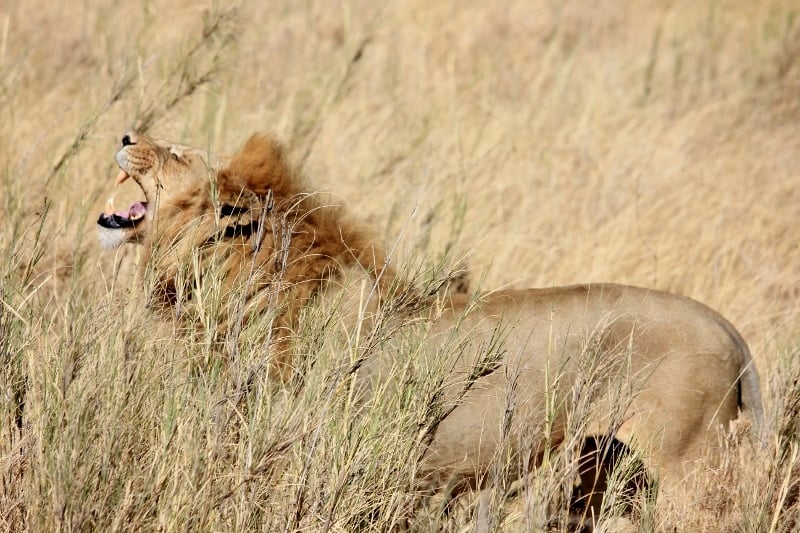
There are two species of this large animal on African soil: black rhino and white rhino, of which the black rhino is sadly listed as critically endangered species. Both of these rhinos are actually grey and have two horns (some rhino species outside of Africa only have one), for which they are sadly poached a lot.
For the largest population of white rhinos in Africa, head over to Kruger National Park in South Africa; meanwhile at Ngorongoro Crater in Tanzania you can spot black rhinos. For a chance to see both species on one safari, you ought to try out the Mkhaya Game Reserve in Eswatini. A few other locations for spotting rhinos in Africa also exist, most notably Ol Pejeta Conservatory, Lake Nakuru National Park, and Kwandwe Game Reserve (where you may have a chance to see all of the Big Five!).

So, which of the Big Five Animals do you fancy seeing the most? Are you planning on choosing a tour specifically to see that specific animal or are you hoping to catch a sighting of all the Big Five on one safari? Many of us are likely dreaming of hopping into a vehicle and heading into a safari once in our lives, and what better experience to come out of it with than having seen the “king of the jungle” or the largest walking animal on Earth!
My Story & Experience:
Having a competitive nature, I was up for the challenge of spotting the Big Five Animals and it turns out that spotting these 5 was a pretty big one. Game on.
We had four days while on safari in Tanzania with Shadows of Africa to spot the Big Five. That was only 1.25 animals to identify per day. Pretty good odds.
Our trip started out promising with witnessing an African Elephant on our first day of safari in Tarengire National Park . Actually, there were a couple dozen elephants roaming the land. Looks like this whole spotting the Big Five thing was gonna be easy. Famous last words.
On day two, we scored big time in Serengeti National Park . It started with finding a male lion. And he was roaring. Do I get bonus points for the roar?
Also on this day there was the sighting of a Cape Buffalo toting a bird on his back. Plus, there was a cheetah. He was pretty far away, but I still saw him. So it counts.
It looked like I was winning this Big Five challenge against myself. And then day three came. There were a lot of repeats of what was already seen, but not the last animal on my Big Five hunt, the rhino.
Even on the last day of safari, in Ngorongoro Crater, we actually all felt pretty confident as we drove through the animal rich land.
Besides, if anyone could help spot us a rhino it would be our Shadows of Africa driver Timothy. I swear he can identify an animal a quarter mile away just by its shape and swagger. And he tried to find us a rhino. Really hard. He even had the CB turned on in case any other safari drivers spotted one first.
They did not.
There are only an estimated 21 rhinos in Ngorongoro Crater. That’s not a lot, considering the hundreds of wildebeest and zebra I had seen in the crater in the first half hour.
We drove to all the spots that the rhinos usually hung out, but came up empty. They had gone into the forest, a place we could only go on foot and there was no way I was stepping out of a jeep that was surrounded by lions, wildebeests and wart hogs.
As the last day on safari came to an end, it became evident that the Big Five would be minus a Big One.
That’s okay, I’m coming back for you Mr. Rhino. Be ready.
UPDATE: I recently returned to Tanzania and finally spotted a rhino at Ngorongoro Crater!
More About Africa
Animal Bucket List: 100 Names of Random Ones to See Freetown Bucket List: 15 Best Things to Do in the Capital of Sierra Leone Sierra Leone Bucket List: 10+ Best Things to Do in the African Country Ugali (Nshima): All About Africa’s Staple Food African Safari in Tanzania: The Ultimate Itinerary and Tour Africa’s Maasai Tribe: The Culture & Traditions of The People Safari Animal Bucket List: 35 Top African Wildlife to Spot Four Seasons Safari Lodge: Luxury in Tanzania’s Serengeti National Park Spot the Big Five on an African Safari Tanzania Safari Bucket List: 23 Activities Not to Miss
30 thoughts on “The African Big Five: The Top 5 Animals to Spot on Safari”
After all you have eaten and experienced, I am surprised you were not the first to jump out for your elusive big one. I discovered your site while making my bucket list after surviving open heart surgery. I truly enjoy reading your adventures. You really helped me make a great bucket list! Kathy
I did think about it for a second, but lions & hyenas really scare me ;) I am so happy to hear that my blog is helping you make a great bucket list after such a major surgery!! And I hope your checkmarks will be plentiful :)
I finally spotted a rhino later than month in South Africa!
Damn you and your rhino Raymond Walsh ;) I am beyond jealous!!
I saw a rock that looks like a rhino, does that count? :-p
LOL! I thought the rock looked like a tent and the piece of wood looked like a cow ;)
Guess you’ll have to visit at least a couple more times. The first time I traveled to Africa, some British tourists told me it was addictive. They were right. I’m headed back, this time, to Namibia where I should finally get the change to see a rhino. I can’t wait!!
Yes, I definitely need to go back to see that rhino (amongst other reasons too). Have a wonderful time in Namibia!
You definitely get bonus points for the roaring lion! I can’t wait to go see them for myself one day!
Wow! What a great experience. Not seeing a rino is a great reason to go back but it seems to me that, ANY, reason would be good enough.
I’d be happy to see four. Last time I went on safari I only saw three. I love that photo of the lion roaring – it’s brilliant!
Okay, now I feel better with only seeing four :)
Hi Annette, that’s such a pity! I went on a safari on the Maara and the same happened to me. I saw many of the big 5, but Mr Rhino didn’t make an appearance.
Great blog, by the way!
Damn Mr. Rhino!! I have to admit that the hunt was so much fun, but the failure not so much :)
Wow! What a great experience. so so lovely photos…
hope you get to see the rhino on your next safari travels. I had a hard time spotting one too and ended up seeing one at the Nairobi national park. Good Luck
Next time, I will not leave Africa until I spot one!
In the images the lion is mourning, small baby elephants try to break the branch of a tree and a buffalo standing all were captured by way of excellent photography.
Hey Annette, I am also planning a safari trip possibly at the end of this year but I was wondering if I set out on my own (trying to get someone to agree to come with..lol) how did you go about finding other possible bucket listers to go with you? Did you just reach out to people who followed your page? or got grouped up with them once you booked? Thanks!
Actually, I was invited to go on the safari by the tour company along with a couple of other bloggers. Though, I believe that if you contact the company they should be able to pair you with some others that will be on safari too. Good luck! Going on safari was amongst the best bucket list experiences I ever had.
Hope you get to come to Africa again sometime soon. If you do, you would love South Africa and the Kruger National Park. We go their every year from Johannesburg and on the first day’s trip into the Park this year, spotted all of the big five pulse most of the Ugly Five. Enjoy your travels.
I had never heard of the Ugly Five!! But, I need to spot the Marabou Stork on that list in addition to the rhino! I would love to go back one day soon.
Hi Annette! Amazing photos! Looks like you truly enjoyed and made the most out of your safari trip. Are you planning to visit again soon? If so, what are you looking forward to seeing? As for me, the next time I go on a safari trip I definitely want to see giraffes and maybe some primates too. Looking forward to reading about your next travel!
I really hope i get to go to a safari! This is so cool!
Hope you can visit the Safari someday.
I am a safari organiser for years and this is one of the most comprehensive safari guide, especially when you want to get the best of African safari. Perfect and pretty much useful for both beginners and pro safari goers. Way to go!
Thank you so much. I’m glad that this can help my readers.
Thanks for sharing amazing tips. The big five can also be found in Uganda when you Murchison falls national park and Ziwa rhino sanctuary while on your way to Murchison falls. Queen Elizabeth National Park is also another place where you can view lions, the tree-climbing lions in Kasenyi Plains.
Loved this post and the details on what to see and where (specifics like the pride of lions). Ps. you definitely get bonus points for the lion’s roar!!
I want to see leopards the most because they are just spectacular to look at and from your post I’ll be researching Kwandwe Game Reserve for a chance to spot all five.
I love the post and is very useful. Thanks so much
Leave a Comment Cancel reply

Hey Bucket Listers! I'm Annette .
I’m a goal obsessed mid-lifer, traveler, experience collector, fear crusher, digital marketer and author with big bucket list dreams. Let's Connect!
Want Inspo To Your Inbox?
I’m giving you practical tips, exclusive tools and the inspiration to stop dreaming about your bucket list and start living it.
Whatcha Looking for?
Home About Blog The Shop Partnerships Contact
Bucket list ideas travel facing fear & anxiety.
Change location
- UK / International
- Call toll-free until 8pm EDT 617-223-4521 617-223-4300 or
- REQUEST A QUOTE
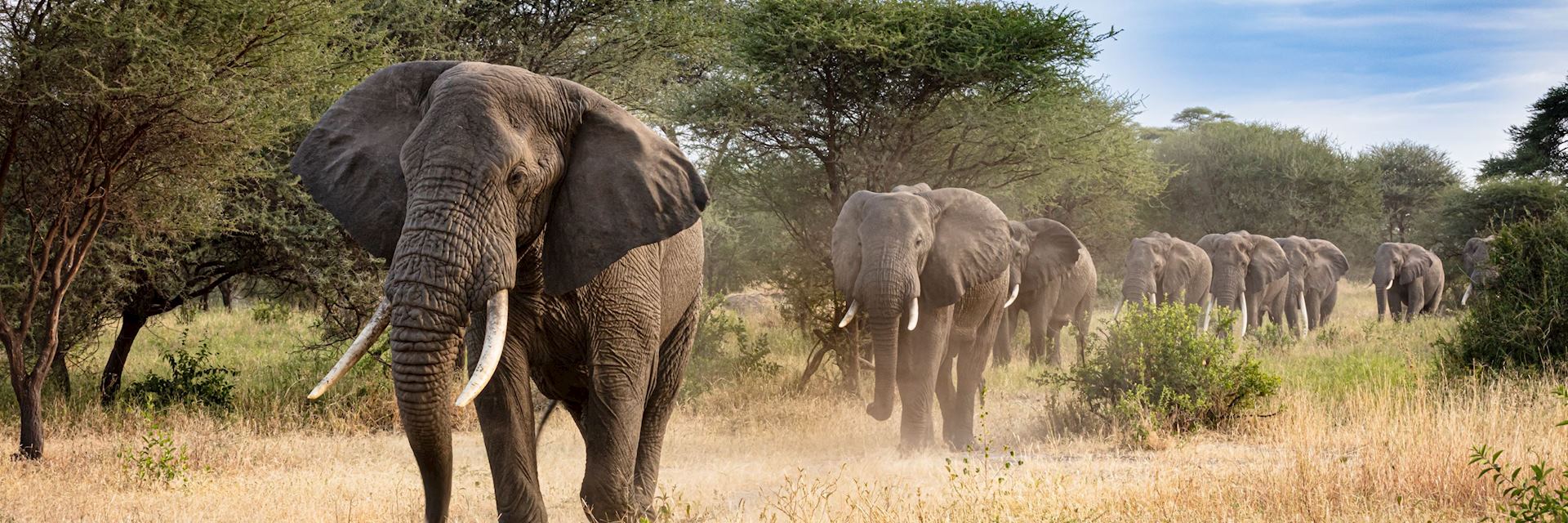
Top 10 safari animals in Africa & where to find them
- South Luangwa National Park
Sweeping savannas, grassy wetlands, and wind-sculpted dunes play host to hundreds of creatures across Africa, from tiny reptiles to the largest mammals on the planet. Which ones capture the public’s attention the most? We’ve delved into UK Google search data to find out.
Below, we reveal the top ten African safari animals and why they’ve earned a spot on our list. We’ve also gathered expert insights from our Africa specialists to let you know where you can see each species in its natural habitat, unveiling the best safari experiences across the continent.
Despite their apex-predator status in the animal kingdom, lions have captured people’s hearts since childhood, with beloved films and whole documentaries dedicated to their hunting prowess. That’s why it’s no surprise to see them on our list of top ten African safari animals. The good news is that you can see lions across Africa with relative ease, though each destination offers a different experience.
If it’s your first safari and you’d like to see all of the Big Five (lions, leopards, elephants, buffalo, and rhinos), you can’t go amiss with a trip to South Africa’s Greater Kruger Region . Or, to witness the drama of the Great Migration, when herds of migrating wildebeest attract opportunistic prides, head to the Serengeti in northern Tanzania .
For a luxury lion-spotting experience, we recommend a trip to Botswana’s Okavango Delta . Alongside safari drives and boat rides, you can head out on foot with a guide who’ll point out the paw prints of resident cats as you walk, before you retreat to your luxury lodge.
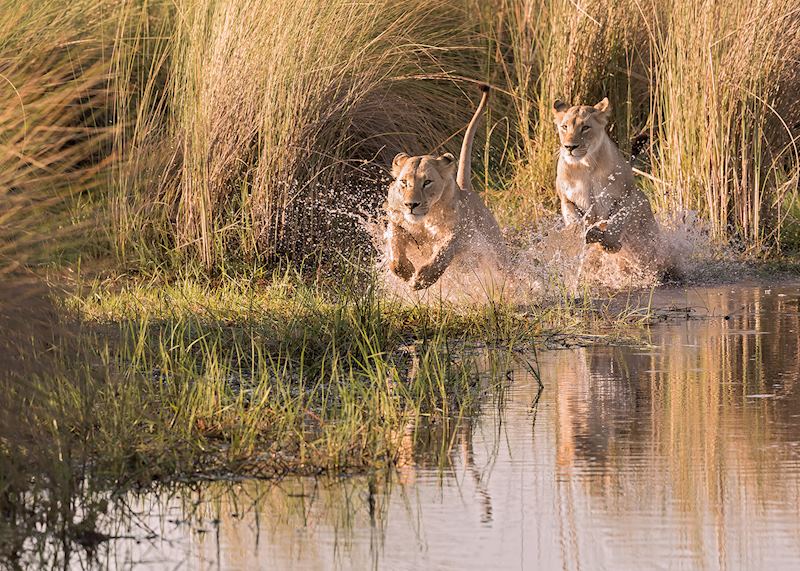
After chimpanzees and bonobos, gorillas are humans’ closest living relatives and share up to 98% of our DNA. It’s perhaps this odd familiarity that makes gorillas one of the top safari animals in Africa. Not only that, but you can only encounter mountain gorillas in the wild — they don’t survive in captivity.
Two of the only places you can get up close with these elusive (and often shy) creatures is in Rwanda’s Volcanoes National Park or Uganda’s Bwindi Impenetrable Forest. Encountering a troop often involves hours of hiking and bushwhacking through primeval forest with an expert guide, but this makes it all the more special when you finally set eyes on them.
To recuperate, you could add on time at the beaches of Zanzibar , doing as much or as little as you want on the sugar-soft sands. Alternatively, expand your safari beyond gorillas and take a primate tracking trip through Rwanda to spot chimpanzees and golden monkeys as well.
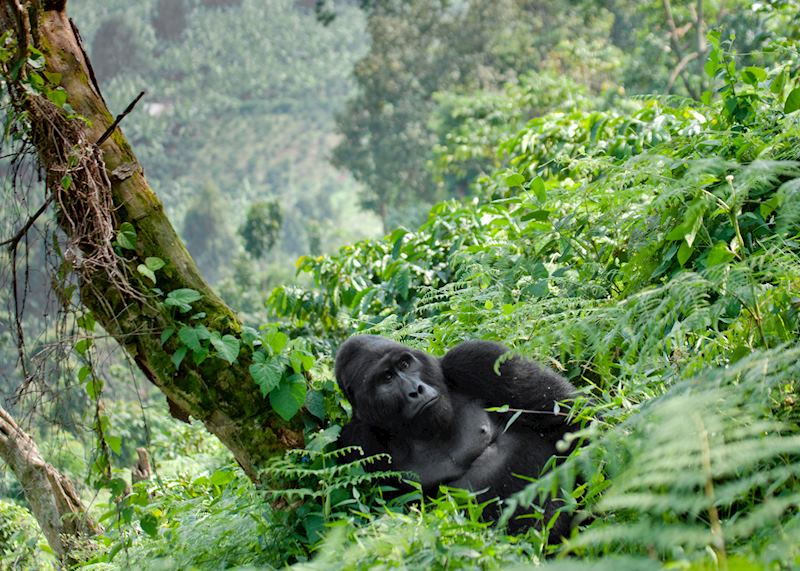
3. Elephant
Towering high above the undergrowth, elephants are the largest land animals currently on the planet, but they’re also gentle giants capable of displaying deep emotions. On safari, you can watch elephant herds frolic in waterholes, walk in convoy trunk-to-tail across the plains, and graze lazily under the sun, all the while learning about their intricate social structures and communication methods.
You’ll spot elephants across Southern and Eastern Africa. However, the highest concentration on the continent is in Botswana’s Chobe National Park, which we suggest pairing with a trip to the Okavango Delta . As you look out for herds among the region’s grassy floodplains, your guide might also point out leopards, cheetahs, and buffalo.
Or, for an entirely different elephant experience, you could opt for Namibia instead . Here, the local population has adapted to the desert climate and you can see herds wander against a stark backdrop of sun-scorched peaks.
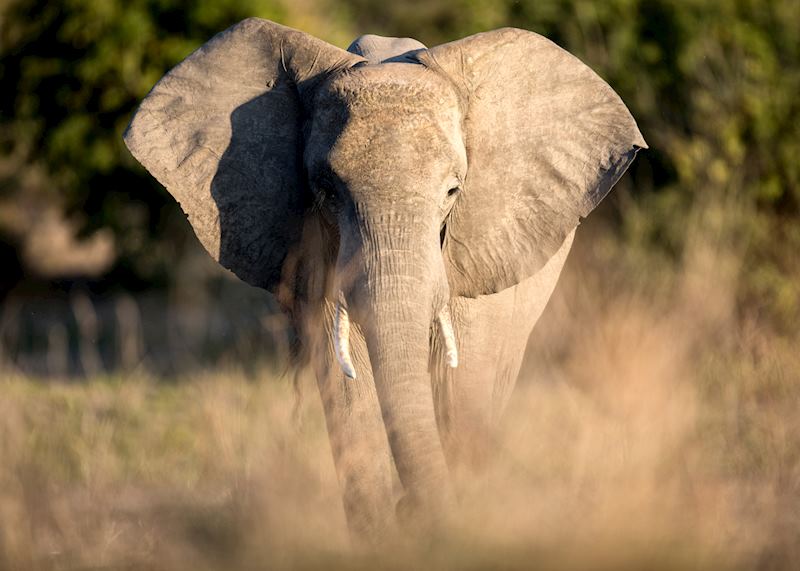
Leaving a trail of dust in their wake, buffalo move in huge herds, often fighting off lions as they go. During drier months, you’ll find them hanging around waterholes and floodplains, congregating in their hundreds for protection. When water is more abundant, they don’t linger as long, moving about constantly in search of food.
You can see buffalo herds in many parks and reserves across East and Southern Africa, but you’re most likely to encounter them wherever there’s a good water source (buffalo need to drink every day). Botswana is one of our top destinations for buffalo sightings, with herds moving between the Okavango Delta and Chobe National Park regularly. You can combine the two regions in a single trip , taking boat and mokoro (canoe) rides to spot the resident buffalo from a different perspective.
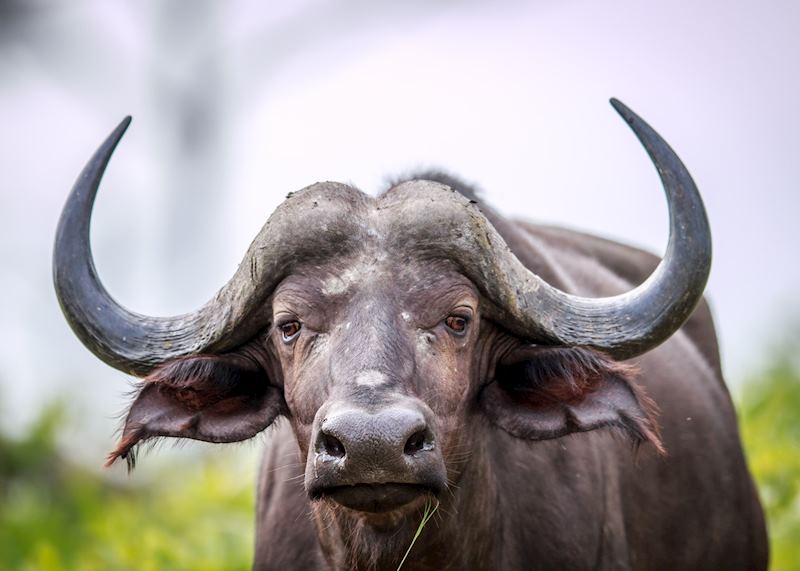
5. Flamingo
In whimsical shades of coral, pastel, and fuchsia, flamingos appear like something out of a fairytale. When flocked together, they paint the landscape in a pearly pink hue and, during breeding season, the males ‘dance’ in unison, heads bobbing and wings flapping as one.
Our specialists recommend taking a trip through northern Tanzania to spot flamingos, hippos, and tree-climbing lions in Lake Manyara before heading into the wilds of the Serengeti. If you’re an avid flamingo fan, you could also venture further north to Lake Natron, where around 75% of the world’s lesser flamingo population is born.
Alternatively, spot these fancy-feathered creatures at Lake Nakuru National Park in Kenya, just a couple of hours’ drive from Nairobi, which you can tie in with a wider safari and beach trip . Here, we recommend staying at a lava-stone cottage at Mbweha Camp , heading out on wildlife drives with your guide to watch the birds blanket the lake in a cloud of pink.
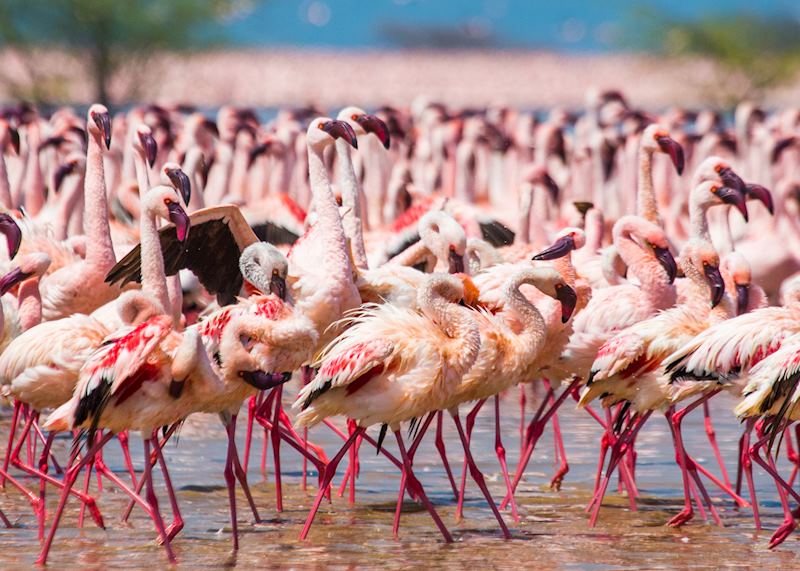
Coat patterns as unique as our fingerprints. Legs that appear to run in slow motion. Winding tongues that grapple with tree branches high above the savanna floor. Giraffes are curious creatures and unlike any other living animal on the planet. For this reason, it’s easy to see why they rank in third place on our list of top ten African safari animals.
On a trip to Nyerere National Park in Tanzania , you can watch as herds of over 50 giraffes congregate at the lakes, sliding into a splits-like position to crane their long necks down to water level. Or, for a rare opportunity to soar above these gangly creatures, take a hot-air balloon ride over the Masai Mara on a luxury safari in Kenya .
Another of our top destinations for giraffe-spotting is Botswana, at Thamo Telele lodge. Located just outside of Maun, the lodge boasts its own herd of 20 giraffes, which graze at the nearby waterhole. During your stay, its team of naturalists can teach you how to identify each individual by their distinct spot patterns. And, a portion of the money from your stay will go toward the Giraffe Conservation Foundation, which supports the species throughout Africa.
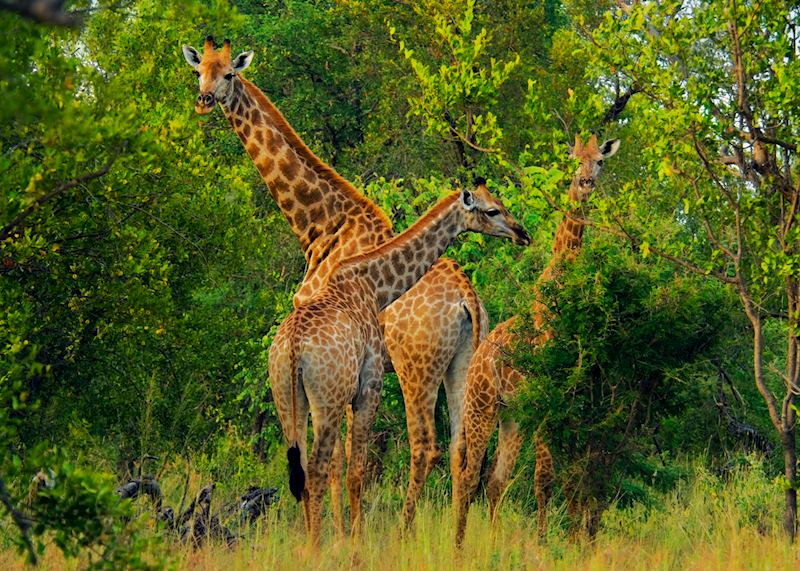
7. Scorpion
Dozens of scorpion species scuttle around Africa’s deserts, grasslands, savannas, and forests, but they’re not often the star of the show on a safari. Nevertheless, their reputation for being dangerous (not all actually are) is perhaps what reels in more adrenaline-oriented wildlife enthusiasts.
Scorpions tend to emerge at night and often steer clear of people, so you don’t have to worry too much about coming across one unwittingly. However, your guides and lodge staff will give you safety advice should you spot one (our specialists also recommend shaking out your shoes before putting them on, just to be safe).
That said, if you do want to proactively glimpse one of these pincered critters, a trip to Namibia’s dunes should be top of your list. Just south of Swakopmund, you can head out with a guide who’ll sift through the sand to unearth Namibia’s smaller creatures, including — if you’re lucky — scorpions. You might also spot dancing lizards and cartwheeling spiders.
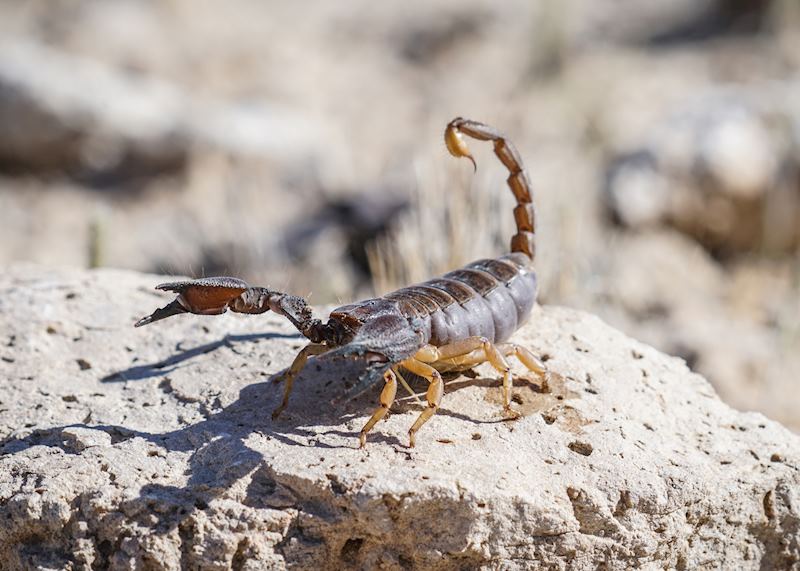
The fastest land animal in the world, the cheetah makes for a thrilling sight on safari. Even if you don’t catch them darting after prey, you can take the time to appreciate their solid black spots, rounded ears, and fuzzy stomachs as they lounge. Unlike leopards, they come out during the day, but they are typically harder to spot.
Though cheetahs are present in many of Africa’s wildlife reserves, including the Serengeti, Masai Mara, and Kruger National Park, our specialists particularly recommend a visit to Etosha National Park on a wildlife-focused trip to Namibia . It has large swathes of grassy plains, ideal for spotting cheetahs (and an array of other big cats), and is far less visited than Africa’s popular parks, meaning you won’t come across many other vehicles on your drives.
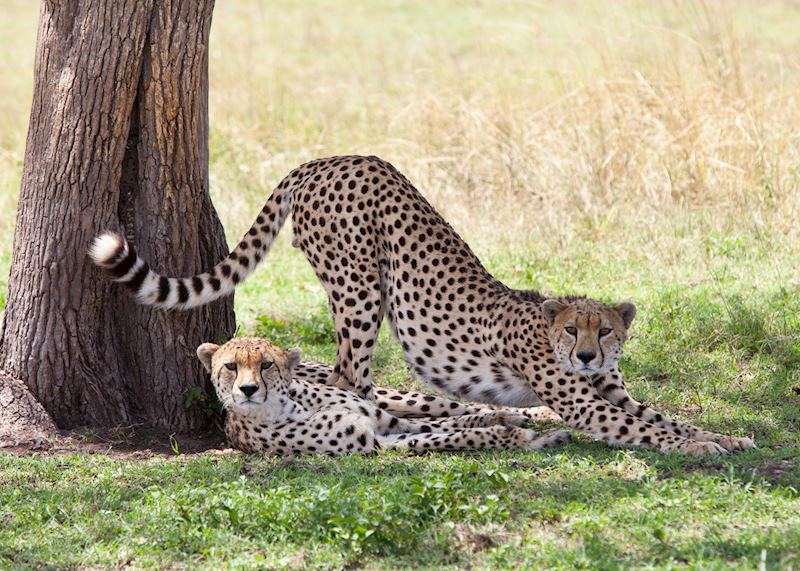
9. Chameleon
With striking color-shifting abilities, it’s no wonder chameleons make it onto the list. Contrary to popular belief, they don’t actually change color to blend with their surroundings, but instead to convey mood, communicate with mates, or to adapt to the temperature. Despite that, chameleons still tend to be hard to spot, so exploring with an eagle-eyed guide is a must.
Namibia’s dunes are the ideal place to spot chameleons — specifically, the Namaqua chameleon. These speedy little creatures change color to thermoregulate in the ever-changing desert climate, turning black in the morning to absorb the heat and a lighter shade in the daytime to cool off.
However, if you want to admire a more diverse array of chameleons, head to the rainforests of Madagascar . The island provides shelter for around half of the world’s species, including the tiny Amber Mountain leaf chameleon, just the size of your fingernail.
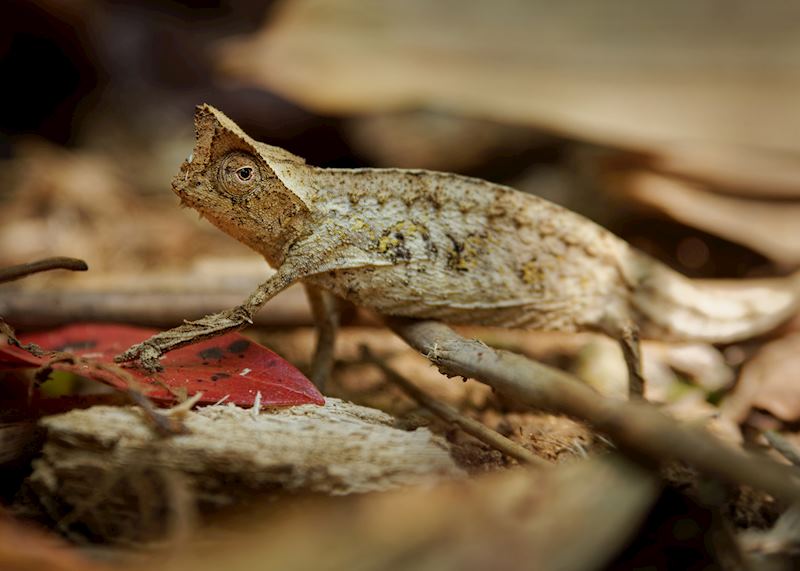
10. Crocodile
With their prehistoric appearance and powerful jaws, crocodiles are always high on people’s safari wish lists and feature in sixth place in our own list of top ten African safari animals. You can watch them basking lazily in the sun, gliding ominously through the water, or grappling with prey as they reveal an impressive collection of serrated teeth.
Perhaps the most exhilarating way to see crocodiles on safari is from the banks of the Mara River during the Great Migration. Here, they lurk and leap out of the water hoping to catch wildebeest and zebras as they dash to the other side. You can witness the drama on a trip to Tanzania or Kenya between July and October.
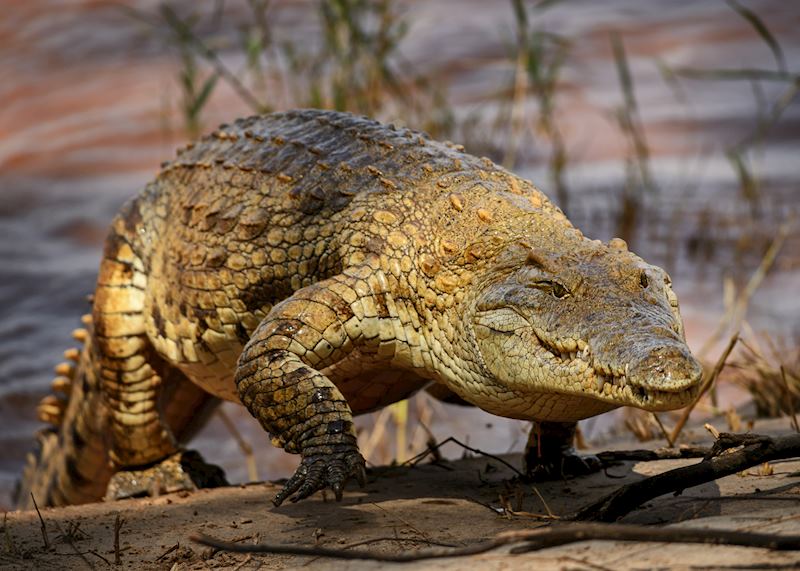
Further reading
- The Ultimate Guide to Planning Your Unforgettable Safari Adventure
- Photographic safaris
- Safaris for less: 3 great-value safari ideas
- Safari on a budget
- Walking safaris
Plan your trip
Tell us about your plans and one of our specialists will plan a unique trip for you...
Request our brochure, The World Your Way

Order your digital copy via email.

Planning an African Safari? Here’s Where You Can Spot the Big 5
V isiting safaris in Africa is an experience high on many travelers’ lists. Having the opportunity to observe wild animals up close in their natural habitat undoubtedly makes for a thrilling and unforgettable trip. Africa’s iconic Big 5 are the African lion, rhinoceros, African elephant, leopard and Cape buffalo. The term “Big 5” and the designation of these animals came about in the 19th century when game hunters listed them as the most dangerous creatures to hunt on foot.
Today, tourism to national parks and reserves helps support the conservation of the animals living there. The funds go towards protecting them from hunters, poachers and other threats. There are camps, resorts and lodges to fit various budgets and experience preferences. Whether you prefer to venture out into the bush in a vehicle, on foot or above in a hot air balloon , there are options to meet the needs of all adventurers, photographers and nature enthusiasts.
If seeing the Big 5 is a must for you, you’ll want to be sure to select safaris in Africa where they’re known to reside. Here are five national parks and reserves home to Africa’s Big 5. Be sure to plan ahead and book your safari well in advance. Accommodations and tours here are in high demand.
Serengeti National Park
A UNESCO World Heritage Site, Tanzania ’s Serengeti National Park is brimming with wildlife of all kinds. Nearly 15,000 square kilometers in size, it is home to 500 different bird species and 300 species of mammals. The protected area is one of the key spots for travelers who want to witness the Great Migration. During this yearly occurrence, around two million wildebeest, zebras, antelopes, gazelles and other herd animals travel from the Serengeti to Kenya’s Masai Mara in search of lush vegetation and water. If you’re hoping to visit during this spectacular natural event, you should plan your visit between June and September.
Maasai Mara National Reserve
If you’re hoping to witness the Great Migration during an African safari at Maasai Mara National Reserve, aim to visit between July and October. This area of preserved savannah wilderness is located in southwestern Kenya, and houses 90 mammal species and 500 bird species. Its landscape is comprised of grasslands, rolling hills an the Talek and Mara Rivers. The national reserve is named for the Maasai people who inhabit the area.
Kruger National Park
Spanning nearly 20,000 square kilometers, Kruger National Park is one of the largest game reserves on the continent. Located in northeastern South Africa , it became the country’s first national park in 1926. In addition to the Big 5, it is inhabited by 150 mammal species, 500 bird species and 100 reptile species. The park’s diversity extends to its plant life with over 2,000 species of plants. Hundreds of archeological sites also can be found in one of the largest safaris in Africa. Kruger is also part of the Kruger to Canyons Biosphere, which UNESCO has named an International Man and Biosphere Reserve.
Etosha National Park
Etosha National Park is located in northwestern Namibia . One of the things that makes it so unique is the massive salt pan set within it. At close to 5,000 square kilometers, the Etosha Pan is the largest of its kind in Africa. It is so large it can be seen from space. Despite the fact that this vast, bare area covers almost a quarter of the park, Etosha National Park has no shortage of wildlife to encounter on a safari. Due to the nutrients and vitamins found in the soil here, its elephants are some of the largest in Africa. After heavy rains, a thin layer of water accumulates on the Etosha Pan, attracting flocks of flamingos.
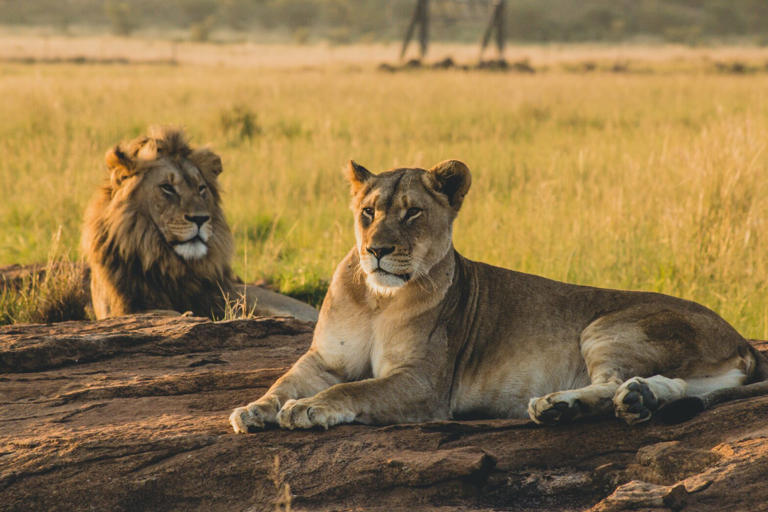

Beyond the Big Five: Lesser-Known African Safari Animals
Disclosure: Some links may be affiliate links. If you buy an item via links on our site, we may earn a commission. Learn more .
While the allure of the Big Five draws many to Africa, the continent’s wild beauty extends far beyond these renowned creatures.
Join us as we journey deep into the heart of the African wild to explore the fascinating world of its lesser-known safari animals.
1. Giraffe ( Giraffa spp.)

The giraffe is the tallest mammal on the planet, growing to 19 feet (5.8 meters) and is one of the biggest highlights of the African safari. They are herbivores, and their enormous height allows them to graze even the tallest trees for the best leaves. What’s more, they have long necks (up to 6 feet (1.8 meters) in length) and a prehensile tongue which allows them to pull the leaves from the trees. Giraffes have a distinct blotched coat with patches that can range in color from tan to almost black, and no two individuals have the same pattern.
Giraffes are generally docile animals but they’re not afraid to stand their ground. Males can often be seen fighting, using their long necks to hit each other in a phenomenon known as necking. However, this is just one form of interaction and communication and giraffes may also be heard making a series of sounds, such as hissing or snorting when they’re threatened.
There are several subspecies of giraffes, so while populations of some types are healthy, others are critical. This means it’s important that safaris are done mindfully with respect for the giraffe habitat and to cause them as little disturbance as possible.
These amazing creatures can be seen mainly in open grasslands and on the savanna but there are some that also frequent woodland habitats. In any case, they’re easy to spot when on safari, if not only because of their height!
When & Where to See Giraffes
When you head off on safari in search of giraffes, you’d do well to look for them in the early morning or late afternoon as this is when they’ll be feeding. The temperature is much cooler at this time of day, making mealtimes more comfortable for these animals.
However, they’re also commonly spotted during the calving season between November and April if you’re keen to spot some babies. That said, it’s also worth noting that this is also the rainy season so be prepared for adverse weather. In the dry season, between June and October, the giraffes will be out more in search of water which is a great opportunity to spot them.
Check out the following areas for the best giraffe sightings:
- The Maasai Mara National Reserve in Kenya
- Amboseli National Park in Kenya
- Tsavo National Park in Kenya
- The Serengeti National Park in Tanzania
- The Tarangire National Park in Tanzania
- The Kruger National Park in South Africa
- The Addo Elephant National Park in South Africa
- Etosha National Park in Namibia (the salt pans are also an incredible sight)
Giraffe Species & Where to See Them
There are five species of giraffe, with several subspecies in each family. Where you go in Africa will determine the type of giraffe you might spot.
Southern Giraffe
The southern giraffe is found across the southern part of the African continent and can be seen on grasslands and savannas as well as in wooded habitats.
Subspecies include the South African, Angolan, and Namibian giraffes and these individuals have a much more rounded face and an irregular pattern on their coats.
Masai Giraffe
There is only one subspecies within this family, and it is sometimes called the Kilimanjaro giraffe, owing to its presence around the base of the mountain of the same name. Masia giraffes are found mainly in Tanzania and Kenya but some other locations in eastern Africa.
These are important players in maintaining vegetation balance in the environment and can be identified by their irregular coat pattern and a sharper, jagged edge to the face.
Reticulated Giraffe
Again, there is only one subspecies of the reticulated giraffe and it can be identified by its reticulated pattern. This is used primarily for camouflage in the semi-arid regions and woodlands that these animals inhabit. You’ll mainly find them in countries such as Ethiopia and Kenya.
Nubian Giraffe
Just one subspecies exists within the family and it is sometimes referred to as the northern giraffe. This species can be found in Ethiopia, Uganda, and South Sudan where they inhabit savannas, shrublands, and wooded areas.
Nubian giraffes have much lighter coloration than other species but do feature an irregular coat pattern.
West African Giraffe
Sadly, the West African giraffe is incredibly endangered and can now only be found in very limited regions of Chad and Niger. It’s thought that there are as few as 600 individuals in the wild.
2. Cheetah ( Acinonyx jubatus )

If there’s one thing that cheetahs are well known for, it’s their speed. These big cats can run up to 81 mph (130 km/h) , and they’re equipped with slender bodies and long tails that help to keep them balanced during these short bursts of activity.
The coat of the cheetah is one of its most obvious defining features, with a spotted pattern. While many people associate a similar pattern with the African leopard, cheetahs are easy to differentiate because of their smaller bodies and small, rounded heads.
The fastest animal on land, cheetahs usually inhabit savannas and grasslands where the vegetation is long enough to conceal them during their hunts. What’s more, with their spotted pattern, these animals are easily able to camouflage. They prey mainly on ungulates and other animals that typically weigh around 50 lbs (22.7 kg) .
The cheetah is a largely solitary animal apart from during breeding when they come together to mate. After this, the mother will raise her cubs for around 18 months, until they’re ready to face the world and hunt alone.
Cheetahs are much more docile than other wild big cats and are not known to be a threat to humans. As such, they’re a popular animal on safaris, especially for photographers who are keen to capture a shot of one running across the savanna.
Sadly, the cheetah is now listed as vulnerable on the IUCN Red List, with a suspected 6000 left in the wild. Even more disheartening is that numbers continue to decline due to human activity like poaching as well as factors such as habitat loss.
When & Where to See Cheetahs
When going in search of cheetahs, you’re best to head out when they’re hunting. This usually occurs when the temperature is cooler in the early morning or late afternoon. During the dry season, like many animals, cheetahs will gather around waterholes, so look here if your safari takes place between June and October.
However, during the calving season between November and April, cheetahs have greater access to vulnerable prey, so they are more frequently spotted.
In any case, some of the best cheetah hotspots are as follows:
- Maasai Mara National Reserve in Kenya
- Etosha National Park in Namibia
3. Hippopotamus ( Hippopotamus amphibius )

While they might not look it, hippopotamuses are among some of the most dangerous animals in Africa. This is not only because of their enormous size (up to 9,920 lbs (4,500 kg) ) but also because of their aggressive nature. That said, they only attack if they feel threatened and are herbivores, so don’t actively hunt humans or other animals. When they do need to defend themselves, they have long, sharp teeth, which they use to clamp down and hole punch their attackers. They’ll also show their teeth as a warning.
In fact, hippos are very social animals that form groups of up 30 individuals, known as a bloat. They communicate using sounds that include honks that can be as loud as 115 decibels !
Hippos are semi-aquatic and are therefore found around water sources like lakes, rivers, and even swamps. Mothers give birth to a single calf every other year in the water, where mating also takes place.
While a boat safari is an excellent opportunity to catch a glimpse of hippopotamuses in their natural habitat, caution is always advised. Travel with an experienced guide, and always be sure to maintain a safe distance. These animals are known to cause more human deaths in Africa than any other safari beast.
When & Where to See Hippopotamuses
Seeing a hippo in the wild is truly one of life’s most amazing treats, but if you want to be sure to catch a glimpse, you’ll need to head out in the late afternoon or evening. There are many boat safaris available during these times of day, and heading out during the breeding season between November and April provides the best chance of seeing these amazing animals.
The dry season is also a good time to spot hippos as they will be more concentrated around water sources. In any case, the following locations are known to provide some of the best opportunities:
- Lake Naivasha in Kenya
- Serengeti National Park in Tanzania
- Ruaha National Park in Tanzania
- South Luangwa National Park in Zambia
- Lower Zambezi National Park in Zambia
- Kruger National Park in South Africa
- The St Lucia wetlands in South Africa
4. Zebra ( Equus spp.)

There are three main species of zebra and while they may look similar, there are some subtle differences. For example, the mountain zebra is much smaller than other species and is found in mountainous regions of Namibia and South Africa. On the other hand, the Grevy’s zebra is much larger, and the stripes are a lot thinner.
The plains zebra is unfortunately listed as Near Threatened on the IUCN Red List , with less than 250,000 individuals left in the wild, and numbers continue to decrease. This species is found in several areas of Africa and can be characterized by its bolder, wider stripes.
A group of zebras is called a dazzle which is pretty fitting for these magical-looking creatures, and groups can number tens of thousands . The benefit of this is that a larger group provides better protection against predators like lions while the zebras graze on grasses and other vegetation. However, the striped pattern of the zebra also acts as a form of confusing camouflage, affording them further protection.
While related to horses, zebras have a much more aggressive and temperamental nature, which is surprising to a lot of people. Still, they’re interesting animals and are known to take long migrations , which can cover a whopping 1,800 miles (2,897 km) !
When & Where to See Zebras
Zebras are often seen on the savanna and are active at most times of the day, so are one of the easier animals to spot. Although, if you’re looking to take great photos, the light first thing in the morning or the early evening is optimal. During the breeding season between November and April, it’s a great chance to see the foals.
As is the case with a lot of African animals, zebras can often be seen gathered around a water source during the dry season between June and September. For the best chance of spotting zebras, check out the following locations:
- The Serengeti National Park in Tanzania is great for seeing plains zebra
- Maasai Mara National Reserve in Kenya is also ideal for spotting plains zebra
- Plains zebra can also be seen in South Africa’s Kruger National Park
- The Grevy’s zebra can be seen in the Samburu National Reserve in Kenya as well as the Lewa Wildlife Conservancy in Kenya
- For mountain zebra, head to the Mountain Zebra National Park in South Africa
- Mountain zebra are also common in the Gondwana Canyon Park in Namibia
5. Sable Antelope ( Hippotragus niger )

The sable antelope is a beautiful species with a dark coat and white markings to the face. However, it’s the horns that are the most impressive feature and they curve back from the head, growing up to 65 inches (165 cm) in length in males. While the females do possess horns, they are slightly smaller.
Horns are used to establish dominance and for self-defense and along with their impressive size (growing up to 1,300 lbs (590 kg)), they’re very well able to look after themselves. Despite this, some subspecies, such as the giant sable antelope are listed as being Critically Endangered.
Sable antelope are found in both woodlands and open areas, where they feed on leaves, grass, and other vegetation. They usually stay close to a water source and during the rainy season, large numbers will come together for breeding.
When & Where to See Sable Antelopes
For great photo opportunities, it’s best to look for sable antelope during the early morning or early evening. However, being diurnal, these animals are active throughout the day. Between May and October, during the dry season, it’s easy to spot them gathered around a water source.
Rainy season is the breeding season and occurs between November and April, so this is a good opportunity to see mothers with their young.
- Hwange National Park in Zimbabwe
- Gonarezhou National Park in Zimbabwe
- Kafue National Park in Zambia
- Chobe National Park in Botswana
- Moremi Game Reserve in Botswana
6. Black-Backed Jackal ( Canis mesomelas )

Found all over the eastern, northern, and southern parts of Africa, the black-backed jackal is a common sight and sound. It has a haunting call which is often heard at night, and these creatures are the stuff of legend. In fact, there is a traditional African story involving the black-backed jackal and the lion in which the latter outsmarts the former, proving its intelligence.
These small to medium sized mammals are carnivorous by nature and prey on small mammals, birds and insects. Despite being mainly carnivorous, they are known to show omnivorous tendencies and may feed on fruits. It’s also not uncommon for them to display scavenger behaviors.
You can identify the black-backed jackal by the dark saddle-like marking on its back which, according to folklore, comes from the animal offering to carry the sun on its back. They are moderately social animals, forming bonded pairs that remain together to raise their pups.
However, spotting the black-backed jackal can be a challenge as they’re largely active at night, spending much of the day in their dens trying to escape the heat of the sun.
When & Where to See Black-Backed Jackals
The best places to spot black-backed jackals are as follows:
- Addo Elephant National Park in South Africa
- Maasai Mara National Park in Kenya
For the best chances of spotting these animals, you’ll want to take a night safari as black-backed jackals are primarily nocturnal. However, there may be some activity late in the afternoon, if you’re lucky.
During the dry season between May and October, black-backed jackals will scavenge so may be easier to spot. Between November and April, you can see mothers raising their young.
7. African Wild Dog ( Lycaon pictus )

The African wild dog is sometimes called the painted dog, and they’re easily distinguished by their patchy coats that come in a range of colors between black and white. They can be found in various habitats across sub-Saharan Africa, where they live in packs of around 40 individuals.
Within these packs, the dogs work closely together to hunt and have one of the best hunting success rates on the continent. The pack is led by an alpha breeding pair, and other members include males, females, and pups. Despite their hunting success and teamwork, they’re now listed as critically endangered and numbers are thought to continue to decrease.
When hunting, African wild dogs go for ungulates as their main prey and will chase their target for extended periods of time, eventually wearing it down and being able to kill it.
When & Where to See African Wild Dogs
African wild dogs are found in many countries in Africa, but it’s best to see them in the early morning or at dusk as they’ll be more active when the temperature is a little lower.
In the dry season between May and October, African wild dogs can be seen around water sources, but if you’re keen to spot the pups then try a safari in the breeding season between November and April.
The following locations are known to be some of the best for spotting these animals:
- Okavango Delta in Botswana
- Selous Game Reserve in Tanzania
- Madikwe Game Reserve in South Africa
8. Nile Crocodile ( Crocodylus niloticus )

The Nile crocodile is perhaps one of the most iconic African species outside of the Big Five, with a ferocious reputation as a killing machine. These enormous reptiles can grow up to 20 feet (6 meters) in length and are the apex predators within their habitat. They’re not fussy about what they eat and may prey on birds, mammals, fish, other crocs and anything that comes into their territory.
The crocodile spends a lot of its time lurking in the water where it waits for prey to pass by and, when it’s within reach, the crocodile will ambush it. With a bite force of 5000 psi, its grip is the most powerful in the animal kingdom.
Spending most of its time in the water, your best chance of seeing a Nile crocodile is around rivers, lakes, and other bodies of water. Here, you may see the females building mound nests where they lay their eggs and keep a close watch over them until they hatch. However, it’s advisable to watch from a distance as there are plenty of horror stories involving attacks on humans. Reports suggest there could be well in excess of 700 attacks each year, with 63% of these resulting in a fatality.
When & Where to See Nile Crocodiles
If you want the chance to see the mighty Nile crocodile, then the following locations come highly recommended:
- The Chobe River in Botswana
- The Mara River in Kenya
- The Nile River in Uganda
- Murchison Falls National Park in Uganda
- The St Lucia Estuary in South Africa
The Nile crocodile is mainly active during the day, with the best chance of a sighting in the morning or early evening. When the dry season comes around between May and October, they’re often spotted basking in the sun. It’s worth noting that between November and April, crocodiles will be breeding and nesting, so it’s a good time to potentially see a young croc.
9. Greater Kudu ( Tragelaphus strepsiceros )

The greater kudu is a large and impressive species of antelope that is easy to distinguish from similar animals. It’s one of the largest antelope species, with males growing as large as 695 lbs (315 kg). They have very muscular bodies and typically reaching a shoulder height of around 39 inches (100 cm).
Like many ungulates, male greater kudus have horns that form a spiral shape and can grow to almost the same size as the animal itself. The record for the longest horns was more than 71 inches (180 cm). Males use their horns to establish territory and will lock with those of another male during a fight. There are examples of males being so stubborn during a fight and not letting go that the horns become permanently locked, and both animals meet their demise.
Greater kudus are usually found in woodlands and bushlands as well as on the savanna, where they are mainly active at night and have a grayish-brown coat that allows them to camouflage. They have a very shy temperament and only form small groups that aren’t very tightly knit. Being so timid, the greater kudu is often one of the more difficult African animals to spot and when they feel threatened, they’ll make a sudden jump and dash off into the bush.
When & Where to See Greater Kudus
As with most other safari animals, the greater kudu can be seen gathered around a water source during the dry season between May and October. Between November and April, during the breeding season, you may have the opportunity to spot mating behaviors or young kudus.
This species is generally more active during the night, so it’s a good idea to take a night time safari. However, there may be some activity in the late afternoon or early evening. In any case, the following locations provide the best opportunities.
- Hluhluwe-imfolozi Park in South Africa
10. Grant’s Gazelle ( Nanger granti )

Named after the British explorer, James Grant, the Grant’s gazelle is a large species of antelope found in eastern Africa. This species can grow up to 35 inches (90 cm) in height and is distinguished by the long, slender, curved horns of the males, which can grow to 26 inches (66 cm) in length.
This is a very distinct looking animal with a beige-orange coat and a white underbelly and is an herbivore that feeds on various vegetation. It can often be seen grazing with other species like wildebeest and zebra and prefers savanna or grassland habitat.
In some, but not all regions, the Grant’s gazelle will take a seasonal migration in search of food and water. However, since they are able to survive without much water, Grant’s gazelle will often remain in an area after other ungulates have left and make the most of the reduced competition for resources. However, this doesn’t mean that they’re not still a target for larger predators like cheetahs and hyenas.
When they are targeted by a predator, Grant’s gazelles have a unique getaway technique that involves running in a zig-zag pattern. What’s more, they’re incredibly agile. They live in herds that are led by a dominant male and these groups can contain as many as 200 individuals .
When & Where to See Grant’s Gazelles
The best places to spot Grant’s gazelles are as follows:
- Ngorongoro Conservation Area in Tanzania
- Kidepo Valley National Park in Uganda
In order to maximize your chances of spotting the Grant’s gazelle, you’ll need to make sure you take a daytime safari, as this is a diurnal species. What’s more, these animals are known for their lengthy migrations, which are often taken in the opposite direction to other animals as they’re not going in search of water.
11. Banded Mongoose ( Mungos mungo )

Found largely on the savannas of sub-Saharan Africa, the banded mongoose has, as its name suggests, a banded pattern along its sturdy, muscular body. While they might look cute, these animals are very effective hunters, although they mainly prey on insects, beetles, and eggs. That said, they will sometimes eat fruits.
Banded mongoose are not large animals and typically grow to around 12 – 18 inches (30 – 46 cm) in length. Still they are highly sociable and this allows them to cooperate when defending themselves against predators. They form very close-knit groups known as troops that usually contain up to 50 individuals.
Each member of the group plays an important role in cooperative hunting and foraging, and communication is done through the use of scent-marking and various vocalizations such as grunts. Interbreeding within these social groups is not unheard of but studies have shown that it may not be as common as we once believed.
Banded mongoose play an important role to local wildlife as they are known to approach other animals like warthogs in order to remove ticks from them.
When & Where to See Banded Mongooses
If you’re keen to spot the banded mongoose then your best chances are during the day. In the breeding season, which coincides with the rainy season, you’re more likely to see mothers and their pups.
Check out the following locations for the best chance to spot these adorable creatures:
12. Rock Hyrax ( Procavia capensis )

The rock hyrax is sometimes called a dassie and these are small, incredibly cute animals with a stout build. As their name suggests, rock hyrax are found in rocky habitats and can be seen all over sub-Saharan Africa. Their distribution is also known to spread as far as parts of the Middle East.
Looking at the rock hyrax, you might mistake it for a type of rodent, but it may surprise you to learn that its closest relatives are actually manatees and elephants . However, unlike their much larger cousins, rock hyraxes are prey for a wide range of creatures, including birds of prey and snakes. They themselves are herbivores, primarily consuming leaves, fruits, and flowers.
The rock hyrax, again as suggested by its name, can often be seen lazing around on the rocks in the sun. They’re usually spotted in groups called bands, which are usually made up of around 20 individuals, one dominant male and the rest females with their young. Males are very territorial and have scent glands to mark out their territory.
When & Where to See Rock Hyraxes
The rock hyrax is mostly active during the day, so taking a daytime safari gives you the best chance of spotting this species. Living in rock habitats means that these animals are active at all times of the year. The following locations are well known for rock hyrax populations:
- Nairobi National Park in Kenya
- Namib-Naukluft National Park in Namibia
- Table Mountain National Park in South Africa
13. Common Waterbuck ( Kobus ellipsiprymnus )

A species of large antelope, the common waterbuck is easy to identify thanks to its dark shaggy coat. These animals also have a ring of white fur around the rump, which is used as a signal for the young when following their parents.
Common waterbucks, as their name suggests, prefer an aquatic habitat which is why they’re almost always found around water sources since they cannot tolerate dehydration. That said, they’re a common sight on the savanna as well as in grasslands and wooded areas across sub-Saharan Africa. It’s here that they’ll graze on grasses.
These animals form medium sized groups that typically number between 6 and 30 and contain members of both sexes, with the males usually being very young. That said, the males are highly territorial and aren’t afraid to fight for dominance from around the age of five years.
When & Where to See Common Waterbucks
The common waterbuck is a diurnal animal, so a daytime safari will give you the best opportunity to spot them. While they are active throughout the year, you’re more likely to spot them during the dry season as they go in search of water.
To optimize your chances of seeing the common waterbuck, consider some of the following locations:
14. Impala ( Aepyceros melampus )

Impalas are one of many antelope species, and they’re probably one of the most easy to recognize. They have a slender body with elegant movements, and their coats are typically reddish brown in color. The females do not possess horns, but those of the male are lyre-shaped and usually black with white markings.
Like many similar species, the impala will perform pronking which is a jumping behavior that allows the animals to express its emotions. They also use this as a way of escaping predators such as hyenas and lions.
Impalas form large groups known as herds which usually number up to 100 individuals . These groups contain both males and females and, during mating season, the males will compete with one another to gain territory and breed with the females. You’ll see these groups in grasslands and savannas as well as in some open wooded areas. This habitat provides excellent grazing opportunities for impala, but they’re not fussy eaters and will often adapt their diet according to the season.
When & Where to See Impalas
You’ll spot the impala in several locations around Africa, but the following are most well known for their healthy populations:
The impala is a diurnal animal, meaning it is more active during the day time. In mating season, it’s a great time to observe these animals as they have some impressive mating rituals and displays.
15. African Civet ( Civettictis civetta )

African civets are part of the Verridae family, which contains a number of feline-like creatures found across sub-Saharan Africa. This species has a spotted coat with dark coloration and a sleek body. But what’s most notable about the African civet is its ability to produce a strong scent from glands near the anus. This scent has often been used in perfumes but is now usually synthetically created to save cruelty.
The African civet is a common sight in its habitat and is listed as being of Least Concern on the IUCN Red List. However, if you want to spot one, then you’ll have to head out at night as they are largely nocturnal when they’ll go on the hunt for small mammals and insects as well as looking for fruits and carrion.
When & Where to See African Civets
To catch a glimpse of the African civet, you’ll need to make sure that you book a night time safari as these are primarily nocturnal animals. The best locations to spot these creatures are:
16. Springbok ( Antidorcas marsupialis )

The springbok is a species of antelope that is most well-known for its unusual jumping behavior, known as pronking. They exhibit this behavior to show their emotions, and this could be anything from excitement to fear and everything in between. When they jump, they can get as high as 9.8 feet (3 meters) !
Growing up to 34 inches (86 cm) in height, the springbok can be characterized by its reddish coloration with a white underbelly. On either side of the animal runs a darker colored stripe, and they’re often found in grasslands and savannas during the day when they’re most active and feed on the vegetation here.
What’s really interesting about springboks is that they are equipped with a scent gland under the tail that allows them to emit a sweaty smelling secretion, which they usually do alongside pronking. It’s thought that the main reason for this scent is to mark territory.
Another amazing thing about the springbok is its migration habits. Migrating much further than any other mammal, these animals can travel hundreds of miles looking for food and water.
When & Where to See Springboks
The distribution of the springbok is considerably less than some of the animals on this list, but there are still a good number of locations where you can spot them, including:
- Kgalagadi Transfrontier Park in South Africa
Being a diurnal species, it’s best to choose a daytime safari. If you have the chance to head out during the dry season then this gives an excellent opportunity to observe these animals during their migration.
17. Hartebeest ( Alcelaphus buselaphus )

While hartebeest numbers were once healthy in Africa, their populations have sadly declined due to factors such as habitat loss. That said, they are listed as being of Least Concern on the IUCN Red List, with an estimated 360,000 remaining in the wild. However, there are several different species, including the red hartebeest, the Coke’s hartebeest, and the Lichtenstein’s hartebeest, and some of these populations are dwindling.
It also doesn’t help that these animals are often preyed upon by carnivores like lions although the males are equipped with curved horns which they use for self-defense as well as for fighting other males to establish territory and to attract females. Hartebeest also gather in large groups because, as they say, there’s strength in numbers.
Hartebeest are grazing herbivores that feed primarily on grasses, so are usually found in grasslands and savannas as well as open woodlands. They have a very unique appearance with a long face and sloping back but are relatively small, usually standing no taller than 3.3 feet (1 meter).
When & Where to See Hartebeests
Hartebeests are primarily active during the day, making this the best time to spot them. The good news is that they remain active throughout the year, so they’re always available to observe. But you’ll need to choose the right location, which could include:

Karen writes professionally, and she is also a published author. She has a passion for the outdoors and tries to spend as much of her free time out in nature.
Similar Posts

Birdwatcher’s Guide: African Safari’s Must-See Birds
When most people go on safari, they look forward to seeing animals like lions, rhinos, giraffes, elephants, and many others. Of course, these are incredible…

Africa’s Lesser-Known on Safari: Little, Shy, Ugly Five
Africa is a huge continent that is home to a diverse range of wildlife. It’s no surprise that people head here to go on safari…

Africa’s Safari Stars: A Guide to the Big Five
Tourism is big business around the world, but when it comes to wildlife, Africa is perhaps the most visited place on the planet. Keen to…

African Safari Tree Species: A Deep Dive
The African Savanna covers a whopping 5 million square miles (12.95 million square kilometers) and here, you’ll find an abundance of animals. But often the…

Exploring Fynbos Flora (Species, Adaptations, & Conservation)
In the south-western corner of South Africa, the Cape Floristic Region boasts a unique ecosystem that is renowned for its remarkable biodiversity. At the heart…

Lions Valley Lodge
A warm, welcoming atmosphere that invites guests to surrender to the magic of the african bush.
Experience the enigmatic charm of the African bush at our lodge, where a warm and inviting atmosphere awaits our guests. Our exclusive, standalone thatched suites provide the utmost privacy, ensuring a truly immersive stay. After an exhilarating game drive, indulge in a soothing massage or take a refreshing dip in our breathtaking infinity pool. Our Executive Chef prepares delectable meals to perfection, served in either the traditional boma or our elegantly adorned dining room. For business needs, our conference facility offers modern amenities, including DSTV, a big screen TV, and standard conference equipment, comfortably accommodating up to 20 adults.
Experience Bush Luxury at Lions Valley Lodge
Game drives
Swimming pool
Walking Safaris
Conference facilities
Private Deck
Bar in the main lodge
All meals included
Air-conditioning
Nespresso machine
Lounge area
His & Hers Shower and Bath
His & Hers Outdoor Shower
Kid friendly
Honeymoon destination
Lodge Reservations Information:
Lions Valley Lodge: Reservations: +27 (0)36 637 9605 Alternative Number: +27 (0)832892716 E-mail: [email protected] Website: www.lionsvalley.co.za/
Please note that we do sometimes have phone signal issues – if so, kindly e-mail us.

Amazing facility. Amazing staff. A once in a life experience. Barrie was our guide and his enthusiasm and knowledge was second to none. Three wonderful meals each day with snacks on game runs. The reserve was not too large and all guide's worked together and were respectful of the animals and each other
Sue Xum – San Diego, Texas (Trip Advisor)
The room - incredibly large and beautifully decorated, we loved the walk in cupboard for our bags, the views and the enormous bed. We enjoyed complimentary sherry on the terrace and the enormous showers. We had an extremely close encounter with a pack of lions who were hunting warthogs within metres of our terrace during the afternoon and were picked up in the safari truck which was, although a bit scary, an incredible experience - we can see why it is called Lion's valley.
Mike – Moscow City, Russia (Trip Advisor)
Enquire about Lions Valley Lodge
Please fill out the form below
- Email Address *
- Phone Number
- Stay up to date with all the latest news from Nambiti and subscribe to our newsletter
- I agree with the storage and handling of my data by this website.
- Name This field is for validation purposes and should be left unchanged.
THE 5 BEST Moscow Safaris
Safaris in moscow.
- Adrenaline & Extreme Tours
- Gear Rentals
- Nature & Wildlife Tours
- 5.0 of 5 bubbles
- District Central (TsAO)
- 3rd Transport Ring (TTK)
- District North-Eastern (SVAO)
- District Eastern (VAO)
- District South-Western (YuZAO)
- Lomonosovskiy
- Ostankinskiy
- Meshchanskiy
- Krasnoselskiy
- Maryina Roshcha (Jewish Quarter)
- Good for Couples
- Good for Kids
- Good for Big Groups
- Adventurous
- Budget-friendly
- Good for a Rainy Day
- Hidden Gems
- Honeymoon spot
- Good for Adrenaline Seekers
- Things to do ranked using Tripadvisor data including reviews, ratings, photos, and popularity.

1. Rybokhotsoyuz

2. Easy Russia Tour Guide
3. UTS GROUP

4. 365AltaiMongolia

5. #1 Russia -Tanzania | Zanzibar, Serengeti Safari & Kilimanjaro Agency | BURIGI CHATO SAFARIS CO LTD

6. Aviashop.Ru

7. Transsib Moscow

8. BASK TOUR
- Easy Russia Tour Guide
- #1 Russia -Tanzania | Zanzibar, Serengeti Safari & Kilimanjaro Agency | BURIGI CHATO SAFARIS CO LTD
- 365AltaiMongolia

Explore Your Travel
Discover your next great adventure, become an explorer to get started!
Travel Plus Tour
Why Travel with Travel Plus Tour?

2000+ Our Worldwide Guide

100% Trusted Tour Agency

12+ Years of Travel Experience

98% of Our Travelers are Happy

Find Your Best Destination
ABOUT TRAVEL PLUS TOUR
World Best Travel Agency Company Since 2008.
At Travel Plus Tour, we are passionate about creating extraordinary travel experiences that leave you with cherished memories for a lifetime. As a leading travel and tourism company, we aim to make your dreams come true, taking you on unforgettable journeys to the most breathtaking destinations across the globe.
- Customized Travel Packages.
- Expert Guidance and Local Knowledge.
- 24/7 Support.
MODERN & BEAUTIFUL
Our Most Popular Adventures
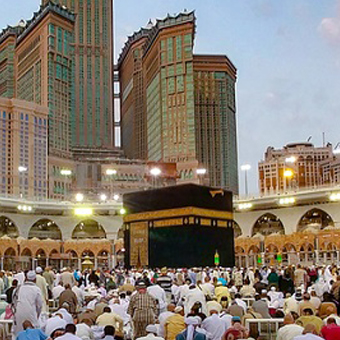
$1500 / Per person
- Mecca & Madina
Overview Embark on a sacred journey with our exclusive Umrah packages. We offer comprehensive travel and tourism services tailored to fulfill your spiritual aspirations. From visa processing to comfortable accommodations and guided tours, our experienced team ensures a hassle-free pilgrimage experience. Contact us today and let us assist you in your spiritual journey. 8 Days […]

Moscow Red City Land
$160 / per person.
- G87P, Birmingham
Lorem ipsum dolor amet consectetur adipiscing sed do eiusmod tempor incididunt.
$170 / Per person
Umrah group 2023.
7 and 14 Night Packages, Umrah Visa, Air Ticket, and Accomodation
Explore the World for Travel

Moscow City
Discover Moscow's iconic landmarks, rich history, vibrant culture, and cosmopolitan charm. Explore museums, theaters, markets, and immerse in its allure.
African Park
Embark on a thrilling African safari adventure, witness diverse wildlife, breathtaking landscapes, and immerse in the natural wonders of untamed beauty.
Norway Lake
Experience the awe-inspiring beauty of Norway's enchanting lake landscapes, where crystal-clear waters meet dramatic fjords and picturesque villages. Unforgettable adventures await!
New York City
Explore the iconic city that never sleeps - New York! Discover world-famous landmarks, vibrant culture, dazzling Broadway shows, and diverse cuisine. Unforgettable memories await!
CHOOSE YOUR PLACE
Popular Destinations
Unlock Your Dream Destination: Choose Your Best Adventure!

Switzerland
Find all destination.
Awesome Hikers
Stunning Places
Miles to Hike
Years in Service
REVIEW & TESTIMONIALS
Top Reviews for Travio
Our trip organized by this Travel Plus Tour was nothing short of amazing. From the moment we landed in Bali, every detail was taken care of. The itinerary was perfectly crafted, with a mix of thrilling adventures, cultural excursions, and relaxing beach days. The local guides were knowledgeable and friendly, adding an extra dimension to our experience. We can't wait to plan our next adventure with them!

Our safari in Tanzania exceeded all expectations! Travel Plus Tour ensured a seamless journey, from booking to the safari itself. The game drives were unforgettable, spotting the Big Five and witnessing the Great Migration was awe-inspiring. Our accommodations were luxurious, and the staff was incredibly attentive. A once-in-a-lifetime adventure we'll cherish forever!

Visiting Lapland with this Travel Plus Tour was like stepping into a winter fairytale. The Northern Lights were breathtaking, and husky sledding through the snowy forests was pure joy. Our kids loved meeting Santa Claus and the elves. The entire experience was filled with warmth, fun, and adventure - thank you for creating such cherished memories!
Exploring Japan with this agency was an unforgettable cultural immersion. Kyoto's ancient temples and traditional tea ceremonies were captivating. Tokyo's vibrant cityscape and modern technology were eye-opening. The cherry blossoms were a dreamy sight! The seamless logistics and knowledgeable guides made it stress-free and rewarding. Highly recommended!

Your New Traveling Idea

IMAGES
VIDEO
COMMENTS
Once mostly targeted by hunters, these large species are "awe-inspiring" sights for safari-goers. If you've gone on an African safari, chances are you've heard of the Big Five, the must ...
Weighing in at not too far short of a ton, the African buffalo (Syncerus caffer) has a reputation for being bad-tempered and dangerous.Whilst a solitary African buffalo is one of the most unpredictable safari animals (and dangerous, hence their inclusion in the term big five animals), they are usually a docile beast when in a herd… aside from their tendency to stampede en masse when alarmed.
African Leopard. The African leopard ( Panthera pardus) is the most elusive of the Big Five animals. Naturally shy and exclusively nocturnal, leopards spend the daylight hours hidden from view. They are excellent climbers, using trees to scan for prey and store fresh kills away from scavengers like lions and hyenas.
Africa's Big 5 Animals are Lions, Leopards, Elephants, Rhinoceroses (black and white) and African Buffalo (also known as the Cape Buffalo). Often revered as the 'must-see' animals on any African Safari, the name Big 5 actually has more sinister origins.
The Big Five animals in pictures. The Big 5 safari animals of Africa in one black and white photo collage. The Big Five of Africa by Kim Paffen (kimpaffen.com) Big Five animal facts 1. African Elephant: a gentle giant. The African savanna elephant is the largest land mammal in the world and can reach up to 3 meters in height and can weigh up to ...
What are the Big Five Animals to Spot on Safari? The Big Five animals are the following African wildlife: African Lion, African Leopard, Cape Buffalo, African Elephant, and the Rhinoceros. The moniker the "Big Five" refers to the five deadliest animals that were popular with big game hunters. However, it is now more commonly used on safari ...
Tourism is big business around the world, but when it comes to wildlife, Africa is perhaps the most visited place on the planet. Keen to experience safaris and the incredible and unique wildlife of this massive continent, Africa welcomes more than 5 million visitors every year.. The Big Five is one of the greatest attractions when it comes to African wildlife, and tourism related to this ...
These animals are among the must-see creatures when visiting the amazing safaris in Africa. So, what are the big five animals? The big five animals of Africa are lions, elephants, African buffalos, leopards, and rhinoceros. When thinking of African fauna, these animals are usually among the first that comes to mind.
For a continent that is known for its amazing wildlife, these are the biggest of the big. These magnificent beasts are Africa's "big five."Learn photo tips f...
An Exploration of the Big 5 African Animals. Of all the wildlife that call the open grasslands home, the African Big 5 animals are the most iconic. While elephants, rhinos, leopards, lions and buffalo are vastly different creatures, they all thrive in the same wilderness environments across multiple countries in Southern and East Africa.
The Big Five includes lions, elephants, buffalos, rhinos, and leopards. These groups of mammals are incredibly popular in game reserves and safari tours. The term 'Big Five' first came into use to describe and identify the five most difficult animals to hunt by foot. Nowadays, the term is more ubiquitous, as the Big Five are much-loved ...
The big-5 game animals are comprised of Rhinocerous, African Elephant, African Lion, African Leopard, and the Cape Buffalo. Let us look at the animals in slightly more detail. Africa's Big 5 Animals. 1. African Elephant. Image. The African Elephant is the biggest land animal in the whole world. From their big ears, precious tusks, dexterous ...
The "Big Five" is probably the most popular phrase in the African safari jargon. More often than not, the first thing a safari newbie will tell you is: "I want to see the big five animals". Almost as if it was the only thing "worthwhile" in the bush. Or people will return from a safari saying, "I saw the big five".
Lions, leopards, elephants, rhinos and Cape buffalo—trophy hunters of the 19th century dubbed these African animals the Big Five for their difficulty to vanquish. Modern safari-goers still delight in capturing these charismatic creatures—in photographs and indelible memories. Learn more about these headliners of the African savanna, then ...
The big six animals on safari, also known as the "Big Six African species," are prominent members of the animal kingdom that are commonly sought after and admired by safari enthusiasts. These magnificent creatures are considered iconic and represent the diverse wildlife found in Africa. ... The Big Five safari animals, which are a major ...
The term "Big Five" was originally coined to refer to the animals on African Safaris that were the hardest and most dangerous to sport hunt. These Big Five animals were African elephants, Cape Buffalo, Leopard, Lion and Rhino. They're still considered the African Big 5 today, although thankfully these days it's more in terms of being ...
The big five. In Africa, the Big five game animals are the lion, leopard, rhinoceros, elephant, and African buffalo. The term was coined by big-game hunters to refer to the five most difficult animals in Africa to hunt on foot, but is now more widely used by game viewing tourists and safari tour operators. They are examples of charismatic megafauna, featuring prominently in popular culture ...
If it's your first safari and you'd like to see all of the Big Five (lions, leopards, elephants, buffalo, and rhinos), you can't go amiss with a trip to South Africa's Greater Kruger Region. Or, to witness the drama of the Great Migration, when herds of migrating wildebeest attract opportunistic prides, head to the Serengeti in northern ...
In addition to the Big 5, it is inhabited by 150 mammal species, 500 bird species and 100 reptile species. The park's diversity extends to its plant life with over 2,000 species of plants.
Join us as we journey deep into the heart of the African wild to explore the fascinating world of its lesser-known safari animals. 1. Giraffe ( Giraffa spp.) The giraffe is the tallest mammal on the planet, growing to 19 feet (5.8 meters) and is one of the biggest highlights of the African safari. They are herbivores, and their enormous height ...
we went on a 5-day safari, organized by Wild Pride. ... Animals - well, we saw them all, Deo knew the right spots, the Big Five of course and many many other animals and all close by. So really a great experience. Hotels - we stayed at the Four Season, the Melia at the Ngorongoro and the Melia at Arusha - all were perfect choices. ...
In Africa, the Big Five game animals are the lion, leopard, black rhinoceros, African bush elephant, and African buf..." The Adventure Family Journal | The big 5 on Safari. In Africa, the Big Five game animals are the lion, leopard, black rhinoceros, African bush elephant, and African buf... | Instagram
Experience the enigmatic charm of the African bush at our lodge, where a warm and inviting atmosphere awaits our guests. Our exclusive, standalone thatched suites provide the utmost privacy, ensuring a truly immersive stay. After an exhilarating game drive, indulge in a soothing massage or take a refreshing dip in our breathtaking infinity pool.
5. #1 Russia -Tanzania | Zanzibar, Serengeti Safari & Kilimanjaro Agency | BURIGI CHATO SAFARIS CO LTD. Multi-day Tours • 4WD, ATV & Off-Road Tours. Open now. 6. Aviashop.Ru. ... 1-Hour West Islands & Eagle Bluff Lighthouse Cruise Seal Snorkeling with Animal Ocean in Hout Bay Postojna Cave & Predjama Castle from Trieste Pompeii, ...
Our safari in Tanzania exceeded all expectations! Travel Plus Tour ensured a seamless journey, from booking to the safari itself. The game drives were unforgettable, spotting the Big Five and witnessing the Great Migration was awe-inspiring. Our accommodations were luxurious, and the staff was incredibly attentive.